Navigation
Install the app
How to install the app on iOS
Follow along with the video below to see how to install our site as a web app on your home screen.
Note: This feature may not be available in some browsers.
More options
You are using an out of date browser. It may not display this or other websites correctly.
You should upgrade or use an alternative browser.
You should upgrade or use an alternative browser.
First ever guided hunt - South Africa
- Thread starter npaden
- Start date
OntarioHunter
Well-known member
- Joined
- Sep 11, 2020
- Messages
- 5,998
A couple of notes. I think you missed the "exit" for customs. I did too. Crazy that it's kinda up to travelers to figure out where customs is located. I followed the crowd down the hall and missed taking a left into customs. Oh well.
They seem to like beef T-bone steaks down there. And what kinda cow makes them? Those steaks are big as a turkey platter! No exaggeration. Certainly not the scroungy beef they raise on East Cape. I am told the cattle on coastal side of the mountains are whoppers. South Africans do like to eat. Me not so much.
I am very much surprised the lodge would put you behind a .375 unless you're hunting buffalo or eland. Most lodges have a bunch of 30-06 loners. A lot cheaper and kinder to shoot than 375. Seems overkill for plains game. That old Model 70 has a fixed magazine. Your 300 WSM probably is clip feed? And a thinner profile rifle? My old Springfield 30-06 holds five in the magazine and one in the chamber. Kinda nice to carry it with empty chamber and still have five rounds at my disposal (though only twice in my life have I shot it dry - still put a moose and elk in the freezer). Personally, I think the utility of detachable box magazines is greatly overrated.
My former PH was just up near Kimberly to bring down a couple of buffalo bulls for the estate where he's now working. He had a miserable night up there as the owner likes to keep lions in pens around residence. Quite the racket.
Looking forward to reading the rest of your adventure. On my first trip I had four animals in the truck before lunch on the first day. But that is unusual.
They seem to like beef T-bone steaks down there. And what kinda cow makes them? Those steaks are big as a turkey platter! No exaggeration. Certainly not the scroungy beef they raise on East Cape. I am told the cattle on coastal side of the mountains are whoppers. South Africans do like to eat. Me not so much.
I am very much surprised the lodge would put you behind a .375 unless you're hunting buffalo or eland. Most lodges have a bunch of 30-06 loners. A lot cheaper and kinder to shoot than 375. Seems overkill for plains game. That old Model 70 has a fixed magazine. Your 300 WSM probably is clip feed? And a thinner profile rifle? My old Springfield 30-06 holds five in the magazine and one in the chamber. Kinda nice to carry it with empty chamber and still have five rounds at my disposal (though only twice in my life have I shot it dry - still put a moose and elk in the freezer). Personally, I think the utility of detachable box magazines is greatly overrated.
My former PH was just up near Kimberly to bring down a couple of buffalo bulls for the estate where he's now working. He had a miserable night up there as the owner likes to keep lions in pens around residence. Quite the racket.
Looking forward to reading the rest of your adventure. On my first trip I had four animals in the truck before lunch on the first day. But that is unusual.
Last edited:
OntarioHunter
Well-known member
- Joined
- Sep 11, 2020
- Messages
- 5,998
A bloodhound for tracking wounded game is certainly not the norm. Interesting. Most PHs use Jack Russell cross. They are small and agile which is important when tracking critters like gemsbuck and bushbuck which can be nasty when wounded. The little dogs have great noses for blood and are very well disciplined.
npaden
Well-known member
Day 3 came rolling around with a plan to be back on the track of the zebra at first light. We had another tracker Tefferi join us to work the single zebra track that had crossed the road to the north to make sure that we didn't get on the wrong set of tracks where they had been mixed together for a while.
We started on the track where we had left off and not far into it came on a spot where it had stopped and bled about as much as we had seen the entire time we had been tracking it. Still really not that much but maybe a 1/4 cup spread out over a area about the size of a dinner plate. With renewed assurance that we were on the right track we continued on.
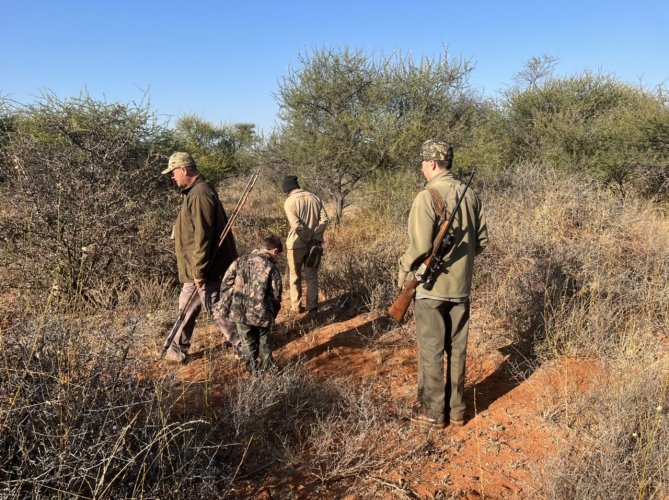
Not much farther along and we end up at a spot where the zebras mixed all up again and some went in one direction and some went the other direction. The track gets harder to follow and we start spending quite a bit of time searching around for it. Pieter feels pretty strongly that we are looking for a dead zebra by now and decides that we should leave Jewel to continue to track it and the rest of us continue to hunt.
Tefferi has followed the single zebra track that crossed the road and it came back to this side of the road and met back up with some of the other zebra tracks and we feel confident that it wasn't the one Eli shot so he gets the truck and comes and picks us up. We head out in the truck with Pieter driving and Teferri on the back. Lood was with us again that morning as well.
I was having a pretty hard time just keeping my bearings on my internal compass sorted out. That morning we had left the lodge driving in one direction and then got on the track and then when we got picked up and we drove past the lodge from the opposite direction than I was expecting. We weren't seeing as many animals as we did the morning of day 2, but we had spent much of the morning tracking the zebra and it was much later today when we started driving around. We made a couple failed stalks on impala but they were short and we got busted pretty quickly. Did see our first ostrich but it was quite a ways off.
Speaking of birds, I was amazed at how many guinea fowl there were around. They can fly so obviously are not restricted by the high fence but I would say there were at least twice as many guinea fowl as there were impala so several thousand at least. There were also some grouse looking birds that they called francolins that we saw quite a few of. It didn't seem that many people must hunt the francolins because they would have been pretty easy to shoot, according to Pieter they didn't hunt the guinea fowl much either but they sure seemed to be pretty wary for a bird. They didn't stick around to figure things out, they just took off making noise pretty much the entire time.
Still seeing plenty of giraffes. Some in groups of 12 or more.
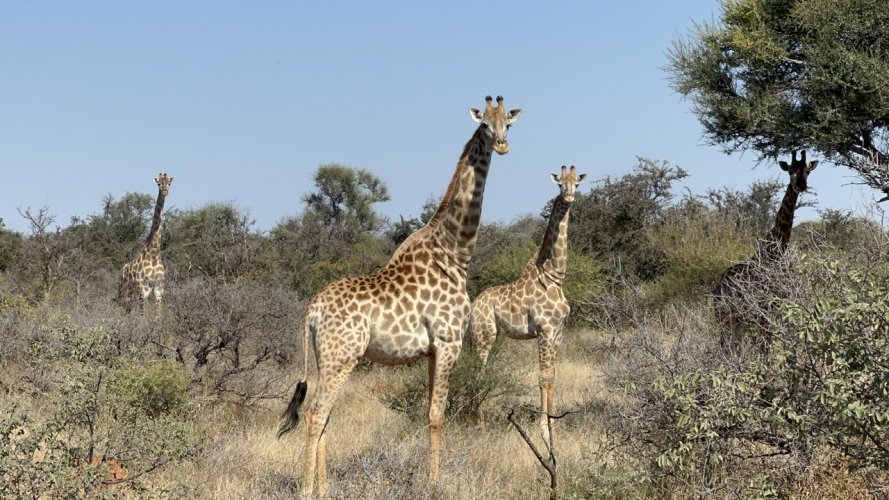
It was getting later in the morning and although we didn't realize we were starting to check out waterholes, that's what we were doing. We stopped about 400 or 500 yards from one and glassed it and Pieter announced that there was a big impala there. We bailed off the truck and headed off through the bush alongside the road so that we wouldn't be seen. The animals seem to be on super duper extra high alert when they are around the waterholes so we were extra sneaky going after them. We get to an open spot and Pieter sets up the sticks and puts his ear plugs in. He tells Eli which one is the big one and tells him to shoot when he is ready. Eli is a little slow getting settled and the impala is quartering away pretty hard so it isn't an easy shot. We are probably about 100 yards away and an impala is not a huge target to begin with. After a bit and some confusion when another impala ran through and scattered them a bit Eli pulls the trigger. The impala is obviously hit, but it takes off for the bush. Pieter tells Eli to shoot it again but it is pretty much running full speed and he can't get on it. Pieter takes the gun from Eli and is tracking it and about to shoot as it disappears into the brush.
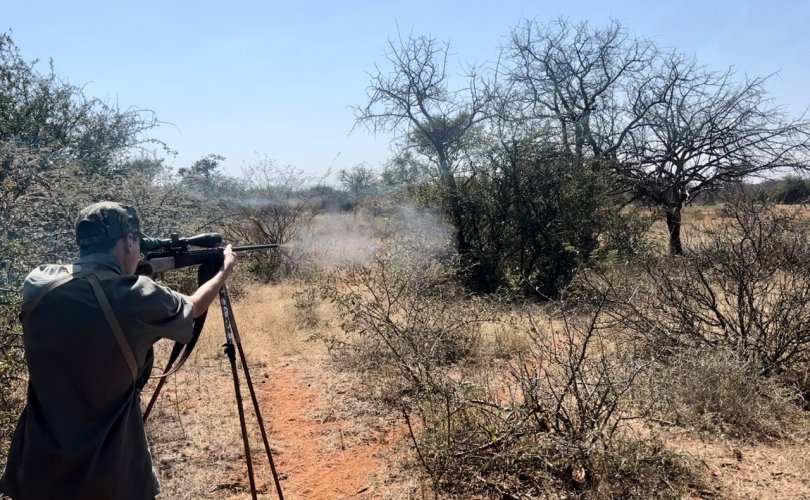
I really thought the impala was hit good and they aren't that big of an animal to begin with and not really known for being tough to kill so I was hoping that we would be able to find it quickly. Eli said he felt good about the shot but he had said that about the zebra too and we still hadn't found it yet. Pieter tells us to go look for blood where it went into the brush but not to try to track it yet until he was there and he went back to get the truck and drove it to where we saw the impala go into the brush. I was pretty proud of myself for finding some blood where it had gone into the brush but there wasn't as much as I was expecting either. There was more than there had been with the zebra though for sure.
While waiting for Pieter to come with the truck a duiker that had been at the waterhole starts heading back to the brush but it is heading straight for me. Nearly every animal we have seen so far has been extremely wary of anyone on foot so this is surprising to me. I pull out my phone and start to video it walking up to me and about 10 yards away it freezes and then bolts off in the other direction. I guess there are stupid animals even in Africa so there is hope for us yet!
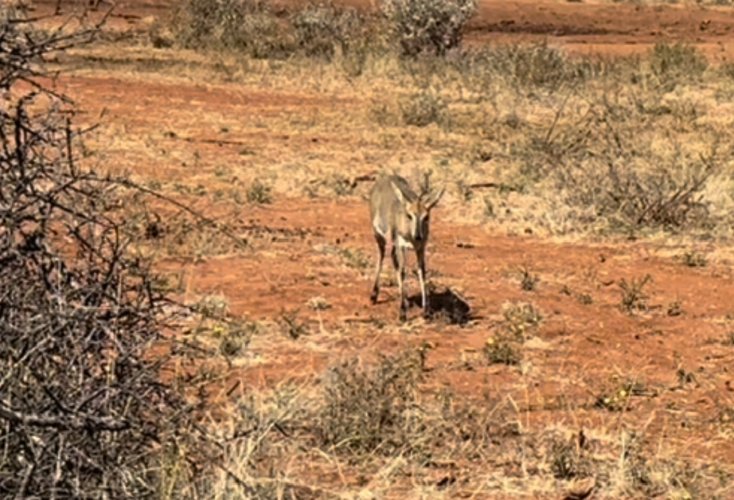
Pieter gets there with the truck and we start working on the blood trail. The blood gets better and there are some spots with some pretty good blood for sure. Looks like it is bleeding each time it makes a stride maybe 3 or 4 yards apart. We follow it pretty easily for about 100 yards and then it seems to dry up. It is in a grassy area so not as easy to track and without the blood we are having a hard time following it. We fan out a bit and look for blood or a fresh track and can't come up with either. Pieter has us work around to a road maybe 50 yards the other side of the thick brush and tells us to work back to the truck looking for any sign that it crossed that road. He works the other side headed back to the truck and we all get back to the truck at about the same time not seeing anything. He is hesitant to go busting through the thick brush and possibly bumping it from it's bed if it is not dead yet so we decide to go back to the lodge and eat and then come back to track it.
After another good lunch we are back to try to follow the track and again get to the same spot and lose it again. We have the dogs this time and they are working but it really doesn't seem like they are on anything. Tefferi goes back to the last blood and starts looking for the track there. Pieter is looking as well and has the rest of us just chill out and wait. It doesn't take long before Tefferi figures out that the impala made a hard turn at that last spot of blood and we are on the track again and not even 50 yards later we find the impala dead. It is pretty obvious it was already dead when we first were tracking it as it is in full rigor now but better to be safe than sorry on waiting a bit before tracking.
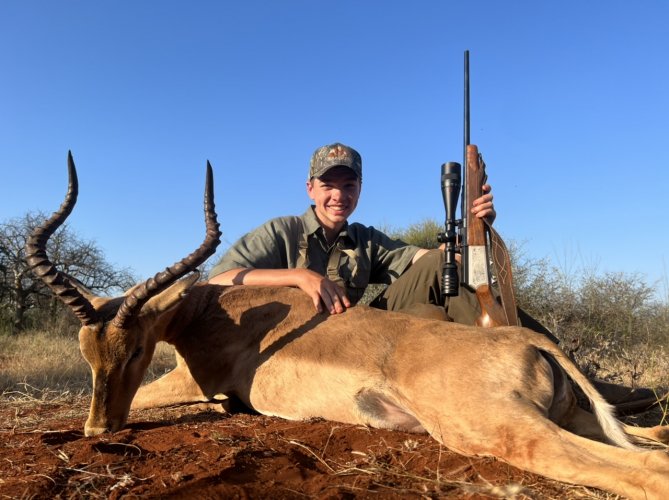
Congratulations all around and we have our first animal recovered. The shot was again a little far back with the entrance into the right hind quarter as it was quartering away pretty severely and Eli must have pulled the shot a little left. The bullet struck the femur and we actually found a bone fragment on the last bit of the blood trail and must have ricocheted back as it exited the guts and some were hanging out a bit. Not the prettiest shot placement and it ruined a little meat with the hindquarter but it was effective and we were happy to have our first animal recovered.
I've always felt that I take pretty decent field photos so while Pieter was messing around with something else I took several and then once they got everything sorted then he took some field photos. Lets just say that I ended up deleting every single picture that I took since his were so much better than mine.
My memory is a little fuzzy on it, but one funny thing that happened in all of this was that both boys were with us and walked back to the truck that was parked near the waterhole. This particular waterhole has some of what they called "paper stickers". They were terrible! I remember heading back to the truck and both boys are just standing there still with their feet curled up as high as they can get them with these stickers covering their feet. You could see the paper stickers on the ground everywhere and they stuck to the soles of your shoes, stuck to the tires of the truck and when you went to pull them off they kind of disintegrated but left the sticker part. Pieter walked over and picked one of the boys up and hauled him to the truck then we drove over to the other boy and picked him up. It took several minutes to get their feet free of stickers. Eli was nice enough to let them know that there has been this new invention called shoes that work perfect for situations like that. They didn't seem to appreciate it very much.
We got it loaded into the truck and headed to the skinning shed for the first time.
We started on the track where we had left off and not far into it came on a spot where it had stopped and bled about as much as we had seen the entire time we had been tracking it. Still really not that much but maybe a 1/4 cup spread out over a area about the size of a dinner plate. With renewed assurance that we were on the right track we continued on.

Not much farther along and we end up at a spot where the zebras mixed all up again and some went in one direction and some went the other direction. The track gets harder to follow and we start spending quite a bit of time searching around for it. Pieter feels pretty strongly that we are looking for a dead zebra by now and decides that we should leave Jewel to continue to track it and the rest of us continue to hunt.
Tefferi has followed the single zebra track that crossed the road and it came back to this side of the road and met back up with some of the other zebra tracks and we feel confident that it wasn't the one Eli shot so he gets the truck and comes and picks us up. We head out in the truck with Pieter driving and Teferri on the back. Lood was with us again that morning as well.
I was having a pretty hard time just keeping my bearings on my internal compass sorted out. That morning we had left the lodge driving in one direction and then got on the track and then when we got picked up and we drove past the lodge from the opposite direction than I was expecting. We weren't seeing as many animals as we did the morning of day 2, but we had spent much of the morning tracking the zebra and it was much later today when we started driving around. We made a couple failed stalks on impala but they were short and we got busted pretty quickly. Did see our first ostrich but it was quite a ways off.
Speaking of birds, I was amazed at how many guinea fowl there were around. They can fly so obviously are not restricted by the high fence but I would say there were at least twice as many guinea fowl as there were impala so several thousand at least. There were also some grouse looking birds that they called francolins that we saw quite a few of. It didn't seem that many people must hunt the francolins because they would have been pretty easy to shoot, according to Pieter they didn't hunt the guinea fowl much either but they sure seemed to be pretty wary for a bird. They didn't stick around to figure things out, they just took off making noise pretty much the entire time.
Still seeing plenty of giraffes. Some in groups of 12 or more.

It was getting later in the morning and although we didn't realize we were starting to check out waterholes, that's what we were doing. We stopped about 400 or 500 yards from one and glassed it and Pieter announced that there was a big impala there. We bailed off the truck and headed off through the bush alongside the road so that we wouldn't be seen. The animals seem to be on super duper extra high alert when they are around the waterholes so we were extra sneaky going after them. We get to an open spot and Pieter sets up the sticks and puts his ear plugs in. He tells Eli which one is the big one and tells him to shoot when he is ready. Eli is a little slow getting settled and the impala is quartering away pretty hard so it isn't an easy shot. We are probably about 100 yards away and an impala is not a huge target to begin with. After a bit and some confusion when another impala ran through and scattered them a bit Eli pulls the trigger. The impala is obviously hit, but it takes off for the bush. Pieter tells Eli to shoot it again but it is pretty much running full speed and he can't get on it. Pieter takes the gun from Eli and is tracking it and about to shoot as it disappears into the brush.

I really thought the impala was hit good and they aren't that big of an animal to begin with and not really known for being tough to kill so I was hoping that we would be able to find it quickly. Eli said he felt good about the shot but he had said that about the zebra too and we still hadn't found it yet. Pieter tells us to go look for blood where it went into the brush but not to try to track it yet until he was there and he went back to get the truck and drove it to where we saw the impala go into the brush. I was pretty proud of myself for finding some blood where it had gone into the brush but there wasn't as much as I was expecting either. There was more than there had been with the zebra though for sure.
While waiting for Pieter to come with the truck a duiker that had been at the waterhole starts heading back to the brush but it is heading straight for me. Nearly every animal we have seen so far has been extremely wary of anyone on foot so this is surprising to me. I pull out my phone and start to video it walking up to me and about 10 yards away it freezes and then bolts off in the other direction. I guess there are stupid animals even in Africa so there is hope for us yet!

Pieter gets there with the truck and we start working on the blood trail. The blood gets better and there are some spots with some pretty good blood for sure. Looks like it is bleeding each time it makes a stride maybe 3 or 4 yards apart. We follow it pretty easily for about 100 yards and then it seems to dry up. It is in a grassy area so not as easy to track and without the blood we are having a hard time following it. We fan out a bit and look for blood or a fresh track and can't come up with either. Pieter has us work around to a road maybe 50 yards the other side of the thick brush and tells us to work back to the truck looking for any sign that it crossed that road. He works the other side headed back to the truck and we all get back to the truck at about the same time not seeing anything. He is hesitant to go busting through the thick brush and possibly bumping it from it's bed if it is not dead yet so we decide to go back to the lodge and eat and then come back to track it.
After another good lunch we are back to try to follow the track and again get to the same spot and lose it again. We have the dogs this time and they are working but it really doesn't seem like they are on anything. Tefferi goes back to the last blood and starts looking for the track there. Pieter is looking as well and has the rest of us just chill out and wait. It doesn't take long before Tefferi figures out that the impala made a hard turn at that last spot of blood and we are on the track again and not even 50 yards later we find the impala dead. It is pretty obvious it was already dead when we first were tracking it as it is in full rigor now but better to be safe than sorry on waiting a bit before tracking.

Congratulations all around and we have our first animal recovered. The shot was again a little far back with the entrance into the right hind quarter as it was quartering away pretty severely and Eli must have pulled the shot a little left. The bullet struck the femur and we actually found a bone fragment on the last bit of the blood trail and must have ricocheted back as it exited the guts and some were hanging out a bit. Not the prettiest shot placement and it ruined a little meat with the hindquarter but it was effective and we were happy to have our first animal recovered.
I've always felt that I take pretty decent field photos so while Pieter was messing around with something else I took several and then once they got everything sorted then he took some field photos. Lets just say that I ended up deleting every single picture that I took since his were so much better than mine.
My memory is a little fuzzy on it, but one funny thing that happened in all of this was that both boys were with us and walked back to the truck that was parked near the waterhole. This particular waterhole has some of what they called "paper stickers". They were terrible! I remember heading back to the truck and both boys are just standing there still with their feet curled up as high as they can get them with these stickers covering their feet. You could see the paper stickers on the ground everywhere and they stuck to the soles of your shoes, stuck to the tires of the truck and when you went to pull them off they kind of disintegrated but left the sticker part. Pieter walked over and picked one of the boys up and hauled him to the truck then we drove over to the other boy and picked him up. It took several minutes to get their feet free of stickers. Eli was nice enough to let them know that there has been this new invention called shoes that work perfect for situations like that. They didn't seem to appreciate it very much.
We got it loaded into the truck and headed to the skinning shed for the first time.
Last edited:
OntarioHunter
Well-known member
- Joined
- Sep 11, 2020
- Messages
- 5,998
Sounds like this trip is an education. And it can be an expensive one. If blood is drawn, get out the checkbook. Trophy fee will be paid whether or not the animal is found. I nearly lost an impala on my last trip. They are tougher than you'd think. Fortunately, we found him piled up inside a thick bush ... after PH and I had walked by it several times. Well hit and bled well but the ram took a dying leap at the end smack into the middle of that crap. Strange how a steady stream of blood suddenly just stopped ... when he went airborne. No cost if it was lost as I was sent out to cull a couple for staff meat. This ram had horns too close together and he had a harem so good one to take out.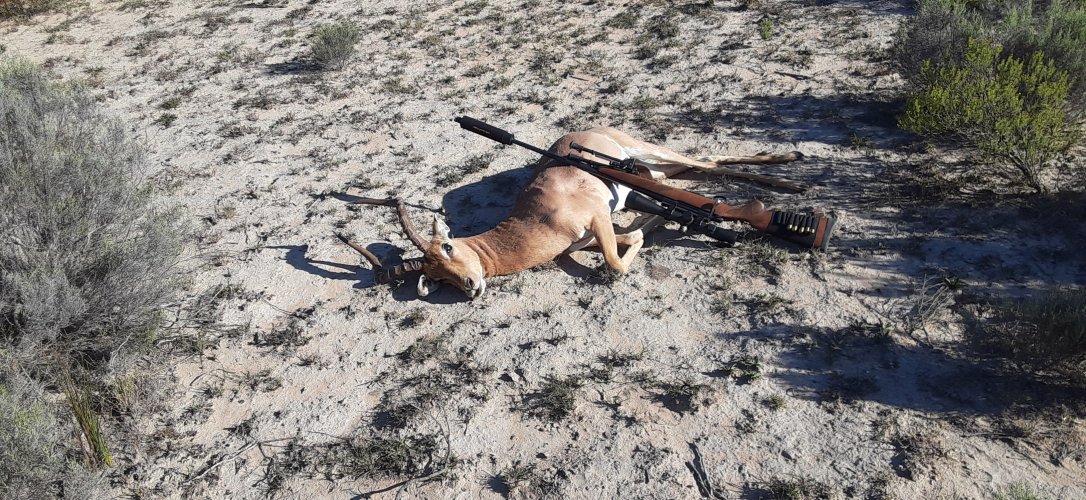
Glad they found Eli's impala. I'm sure he was getting bummed after the problems finding the zebra. He needed a lift.

Glad they found Eli's impala. I'm sure he was getting bummed after the problems finding the zebra. He needed a lift.
Valley1320
Well-known member
Loving the write up so far!! Looking forward to more!
RobertD
Well-known member
Enjoying this. Hope we find our zebra next
npaden
Well-known member
Sorry I'm a bit slow getting back started. Work has been interfering a bit. My pictures ended up a little out of order. This first one was relaxing a little after lunch with the twin boys. They were amazing kids and loved everything about everything. Here my son was showing them a few things on his computer after lunch before we headed back out to find the impala. Pretty neat place to hang out.
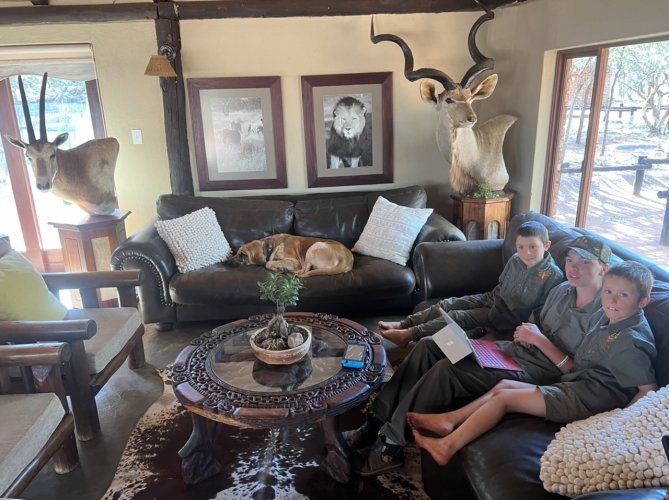
Still on day 3. We ended up dropping the impala at the skinning shed probably a bit after 3 pm. We had discussed relaxing the rest of the day but we were nearing the end of day 3 with only one animal delivered to the skinning shed so we decided to go back out for a little while at least. This was Sunday so the weekend for the boys who were still in school so they were very excited to be going out with us. A pretty full crew with all of us on the bench but we made it work.
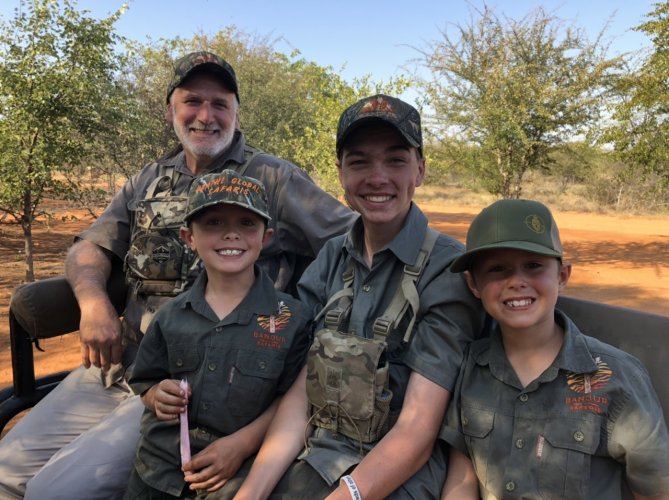
We end up seeing a big group of impala and Pieter says one of them is a big big one. I'm starting to get his trophy size lingo sorted out and pretty sure the scale goes 1. nice one (which is a mature animal and just big enough to consider shooting), 2. big one (nice mature animal and on the shooter list), 3. big big one (a little bigger than a big one), 4. Giant (very big one, anyone would be very happy to shoot it) and then 5. Monster (Only used a couple times the entire time).
We bail off the truck and they continue on while just Pieter and I go after the impala since Eli already has his. We are tracking them well and catch a glimpse here and there but they are just out of sight most of the time. The wind again is not our friend and after about 1/2 mile the wind ends up at our back as we are tracking them. We circle to try to intercept them upwind and they end up dodging us. This seems to be a pretty consistent theme so far. As inconsistent as the wind is, the animals have it pretty well figured out that if they are traveling they need to be moving into the wind. There are no thermals here, just the dreaded light and variable wind. It wouldn't be so bad if you were making 200 or 300 yard shots, but most of the time we are needing to be at 50 yards or less to even get a glimpse of them so the wind is critical. We end up bailing on this group and make it to the road and radio to get picked up. There's a problem and the 2 spare tires are now in play. They are changing out a flat that wooshed out after they dropped us off.
Instead of sitting and waiting Pieter took me on a walkabout. Pieter knows this property like the back of his hand and at this point I'm pretty much stepping on virgin ground to me with every step I make. We make a circuit that ends up near a waterhole but there isn't anything there. It is now getting close to sunset and we start working our way back in the general direction that we started out. As we are heading back we see some wildebeest about 100 yards away. They know something is up but they don't have us pegged. Some snorts and stomps and they kind of run off parallel to where were are going so we just keep heading that way. We play cat and mouse with them for maybe 1/2 mile and never really get close, but never get too far away either. It's getting close to dark and Pieter spots a mature bull with a somewhat clear shooting lane about 75 yards away. He is quartering to us fairly severely. He sets up the sticks and says that it is a mature bull and to shoot him. I get on the sticks and find his front shoulder and am steady and pull the trigger. I can't see anything, but Pieter says he is down and gives me a high five and says nice shot. It is getting close to dark and we go over to where he dropped and we can see the marks where he landed up he is not there. It's too dark to really see any blood but we can see the tracks where it headed off with the rest of the herd and start tracking it.
The tire is now changed and a radio call verifies that they heard the shot and are on their way. With the rapid approach of darkness, they let the dogs loose right away and after some back and forth they seem to get on the track and start after it. We are still following the track and get to the road and can see where the main group crossed and do see a single track heading down the road but it is getting dark and right about that time the dogs start baying big time. We quit the track and start to follow the dogs as they are obviously on something. We move off very briskly after them and they continue to bay steady moving away from us. It's now pretty close to full dark and neither of us have a headlamp but we keep following in the direction that the dogs are going. It is disconcerting that they are moving so far. I'm starting to second guess my shot placement with the hard quartering to angle and with the struggles we have had getting animals to the skinning shed so far.
We have probably followed the dogs close to a mile when they go quiet. It is really dark now to the point it is a bit hard to walk without falling in the dark and Pieter starts calling for the dogs. We start moving in a different direction that turns out to be toward a road that is only a few hundred yards away. On the way there we encounter something not too far away and Pieter says "Leopard?". Encountering a leopard in the dark wasn't high up on my priority list but it's pretty had to see what it is. It turns and moves off and Pieter borrows my cell phone for the flashlight and shines it on the track. It's an anteater. We follow it for a little and he says he can smell it. Evidently they have a distinct smell but I really didn't smell it. We move back to the road and he radios where we are and we wait for the truck and keep calling for the dogs. First one shows up and then shortly thereafter the other one does. He uses my cell phone for a flashlight again and checks the dogs to see if they have any blood on them and they don't. The truck arrives quickly and we load up and start heading back to the lodge. Pieter doesn't seem that concerned and says we will come back first thing in the morning and get on the track.
Here's another picture of the dogs. The brown one (Baba) is just over a year old and the other is 3 or 4. In my opinion the white and black one (Samuel) was the best tracker and when he bayed it usually meant something.
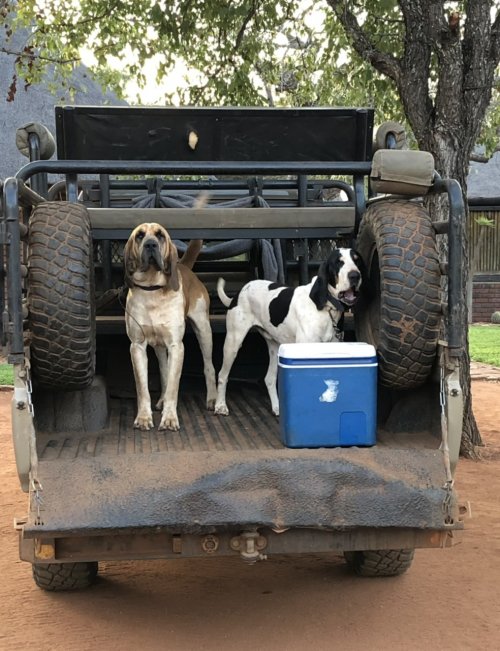
I'm feeling sick and replaying everything through my head. Hard to imagine that I could have blown a 75 yard shot off of sticks but the evidence seems to indicate that it may have happened.
Day 3 ended with 8.5 miles walked. Same as day 2. Some of the walking is at a very slow pace and some of it is brisk. I don't have that stat available to me but it would be interesting to see the moving time as some of the slow walking following a track takes just as much out of you as walking at a normal pace even though you are covering half the distance per hour.

Still on day 3. We ended up dropping the impala at the skinning shed probably a bit after 3 pm. We had discussed relaxing the rest of the day but we were nearing the end of day 3 with only one animal delivered to the skinning shed so we decided to go back out for a little while at least. This was Sunday so the weekend for the boys who were still in school so they were very excited to be going out with us. A pretty full crew with all of us on the bench but we made it work.

We end up seeing a big group of impala and Pieter says one of them is a big big one. I'm starting to get his trophy size lingo sorted out and pretty sure the scale goes 1. nice one (which is a mature animal and just big enough to consider shooting), 2. big one (nice mature animal and on the shooter list), 3. big big one (a little bigger than a big one), 4. Giant (very big one, anyone would be very happy to shoot it) and then 5. Monster (Only used a couple times the entire time).
We bail off the truck and they continue on while just Pieter and I go after the impala since Eli already has his. We are tracking them well and catch a glimpse here and there but they are just out of sight most of the time. The wind again is not our friend and after about 1/2 mile the wind ends up at our back as we are tracking them. We circle to try to intercept them upwind and they end up dodging us. This seems to be a pretty consistent theme so far. As inconsistent as the wind is, the animals have it pretty well figured out that if they are traveling they need to be moving into the wind. There are no thermals here, just the dreaded light and variable wind. It wouldn't be so bad if you were making 200 or 300 yard shots, but most of the time we are needing to be at 50 yards or less to even get a glimpse of them so the wind is critical. We end up bailing on this group and make it to the road and radio to get picked up. There's a problem and the 2 spare tires are now in play. They are changing out a flat that wooshed out after they dropped us off.
Instead of sitting and waiting Pieter took me on a walkabout. Pieter knows this property like the back of his hand and at this point I'm pretty much stepping on virgin ground to me with every step I make. We make a circuit that ends up near a waterhole but there isn't anything there. It is now getting close to sunset and we start working our way back in the general direction that we started out. As we are heading back we see some wildebeest about 100 yards away. They know something is up but they don't have us pegged. Some snorts and stomps and they kind of run off parallel to where were are going so we just keep heading that way. We play cat and mouse with them for maybe 1/2 mile and never really get close, but never get too far away either. It's getting close to dark and Pieter spots a mature bull with a somewhat clear shooting lane about 75 yards away. He is quartering to us fairly severely. He sets up the sticks and says that it is a mature bull and to shoot him. I get on the sticks and find his front shoulder and am steady and pull the trigger. I can't see anything, but Pieter says he is down and gives me a high five and says nice shot. It is getting close to dark and we go over to where he dropped and we can see the marks where he landed up he is not there. It's too dark to really see any blood but we can see the tracks where it headed off with the rest of the herd and start tracking it.
The tire is now changed and a radio call verifies that they heard the shot and are on their way. With the rapid approach of darkness, they let the dogs loose right away and after some back and forth they seem to get on the track and start after it. We are still following the track and get to the road and can see where the main group crossed and do see a single track heading down the road but it is getting dark and right about that time the dogs start baying big time. We quit the track and start to follow the dogs as they are obviously on something. We move off very briskly after them and they continue to bay steady moving away from us. It's now pretty close to full dark and neither of us have a headlamp but we keep following in the direction that the dogs are going. It is disconcerting that they are moving so far. I'm starting to second guess my shot placement with the hard quartering to angle and with the struggles we have had getting animals to the skinning shed so far.
We have probably followed the dogs close to a mile when they go quiet. It is really dark now to the point it is a bit hard to walk without falling in the dark and Pieter starts calling for the dogs. We start moving in a different direction that turns out to be toward a road that is only a few hundred yards away. On the way there we encounter something not too far away and Pieter says "Leopard?". Encountering a leopard in the dark wasn't high up on my priority list but it's pretty had to see what it is. It turns and moves off and Pieter borrows my cell phone for the flashlight and shines it on the track. It's an anteater. We follow it for a little and he says he can smell it. Evidently they have a distinct smell but I really didn't smell it. We move back to the road and he radios where we are and we wait for the truck and keep calling for the dogs. First one shows up and then shortly thereafter the other one does. He uses my cell phone for a flashlight again and checks the dogs to see if they have any blood on them and they don't. The truck arrives quickly and we load up and start heading back to the lodge. Pieter doesn't seem that concerned and says we will come back first thing in the morning and get on the track.
Here's another picture of the dogs. The brown one (Baba) is just over a year old and the other is 3 or 4. In my opinion the white and black one (Samuel) was the best tracker and when he bayed it usually meant something.

I'm feeling sick and replaying everything through my head. Hard to imagine that I could have blown a 75 yard shot off of sticks but the evidence seems to indicate that it may have happened.
Day 3 ended with 8.5 miles walked. Same as day 2. Some of the walking is at a very slow pace and some of it is brisk. I don't have that stat available to me but it would be interesting to see the moving time as some of the slow walking following a track takes just as much out of you as walking at a normal pace even though you are covering half the distance per hour.
Last edited:
Salmonchaser
Well-known member
- Joined
- Nov 12, 2019
- Messages
- 2,601
Wildebeest are tough, hit mine four times in front of the diaphragm. Finally watched him fall over. Good luck
npaden
Well-known member
Dinner that night was bushbuck stew. The lodge had WiFi but South Africa seems to be blocked by a lot of different internet sights so I wasn't able to get my email or post on Hunttalk. I really didn't have enough time to post anyway as we were pretty much going from dawn to dark every day with a short break each day at the lodge for lunch. We still didn't have our luggage but I was able to keep track of it with the airtags I had put in it. It had finally at least started moving our way! Looking at the airtags all of the bags were now in Zurich where we were initially supposed to have had our layover. There was a flight that should be arriving in Johannesburg from Zurich the next morning so it was looking like if things went well we would have our luggage soon.
We really weren't having any hardships by not having it though. The clothes they had purchased for us or were letting us borrow were working pretty well. With the daily laundry service each of us now had 2 sets of clothes that we were rotating back and forth on. Pieter was close to my size and I was borrowing a couple pairs of his pants and one of his shirts. The boots/shoes they were letting us borrow were probably better than the ones that we had packed.
It was a fairly sleepless night for me thinking about the wildebeest and I was ready and raring to go the next morning to go get back on the track. A quick breakfast and we were off.
Day 4. Again I was confused on exactly where we had been the night before. The skinning shed is 4 or 5 miles from the lodge and when we had left the skinning shed the previous afternoon to hunt we went in one direction, then driving back to the lodge in the dark we came in from a different direction and now heading out to go start tracking the wildebeest it seemed that we were going in a different direction. There are some mountains to the south that you can see if you are looking closely and up high on the truck, but once on the ground you usually can't see them because of the brush. At this point I started getting tired of having no idea where I was so I started paying closer attention to the sun direction and even used my compass on my phone a couple times to verify which direction we were going.
It didn't seem like we had gone nearly as far as I was expecting to get back to where I shot the wildebeest but as we are driving up there is my wildebeest lying dead about 15 yards off the side of the road. At first I was confused as I didn't think we had gone far enough that there was just a random wildebeest lying there dead, but then I realized it was mine.
Looking at everything in the daylight it hadn't gone but about 100 yards from where I had shot it, but it had gotten there in a big S pattern. The dogs must have run within 20 or 30 yards of it but with the severe quartering to angle of the shot there was no exit and there was zero blood so they had just missed it. Looking back on the tracks from the night before you could see our boot tracks where we followed the single track that had broken off from the rest of the group and if it had been light we would have seen him piled up maybe 30 yards in front of us. That was right about the time that the dogs had started baying and when they did we had quit following that single track and went after them. We were so close to finding him the night before but just missed finding him.
After quite a bit of laughter and a quick prayer of thanksgiving we got things setup and took the field photos and got him loaded up. The early morning light with an overcast sky made for the perfect lighting for the pictures.
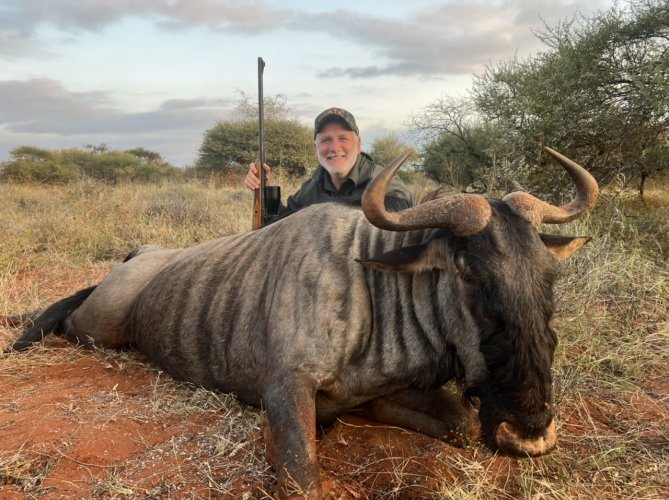
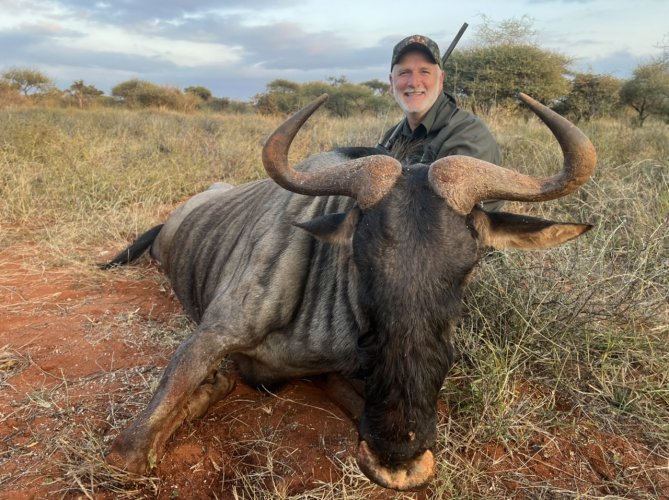
The setup that they had for loading larger animals into the truck was pretty slick. They pulled the winch out about 30 feet and put a post into the cage setup on the truck that guided the cable back behind the truck. Hook the cable to the animal and winch it right into the bed. Worked really well.
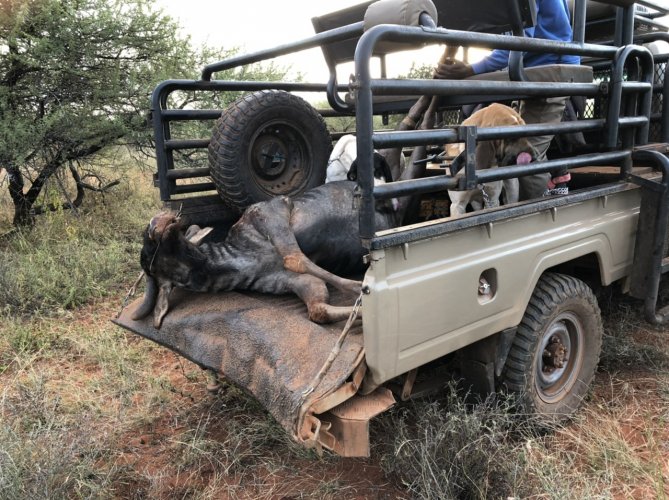
I can't remember if I mentioned it or not yet, but the bent tailgate was from having a client drive one of their other land cruisers. Pieter was driving this one and the client was driving the other and when Pieter stopped the client didn't notice and ran smack into the tailgate. Having it bent like that actually seemed to help loading, but he was working on getting it replaced. They are really neat vehicles and work perfectly for what he does with them the way they are set up.
After getting him loaded up we made our second trip to the skinning shed. Earlier they had just carried the impala over to it, but with the wildebeest we backed up and saw them running the hoist and everything. It was a pretty slick setup with a system for everything.
As you dropped off each animal you needed to let them know what you wanted them to do with it. On the impala we asked about saving the hide and he didn't really think they were worth saving and tanning. They are thin and the older rams we were targeting are generally not as pretty and soft as a younger animal would be. On the wildebeest I was originally thinking the same thing, just getting the skull, but talking with some other people and with Pieter they said the wildebeest hides make excellent rugs. When you get close up to them they actually have some really pretty striping and the fur is quite soft. So that's the plan for the wildebeest, a euro mount and a flat skin.
We really weren't having any hardships by not having it though. The clothes they had purchased for us or were letting us borrow were working pretty well. With the daily laundry service each of us now had 2 sets of clothes that we were rotating back and forth on. Pieter was close to my size and I was borrowing a couple pairs of his pants and one of his shirts. The boots/shoes they were letting us borrow were probably better than the ones that we had packed.
It was a fairly sleepless night for me thinking about the wildebeest and I was ready and raring to go the next morning to go get back on the track. A quick breakfast and we were off.
Day 4. Again I was confused on exactly where we had been the night before. The skinning shed is 4 or 5 miles from the lodge and when we had left the skinning shed the previous afternoon to hunt we went in one direction, then driving back to the lodge in the dark we came in from a different direction and now heading out to go start tracking the wildebeest it seemed that we were going in a different direction. There are some mountains to the south that you can see if you are looking closely and up high on the truck, but once on the ground you usually can't see them because of the brush. At this point I started getting tired of having no idea where I was so I started paying closer attention to the sun direction and even used my compass on my phone a couple times to verify which direction we were going.
It didn't seem like we had gone nearly as far as I was expecting to get back to where I shot the wildebeest but as we are driving up there is my wildebeest lying dead about 15 yards off the side of the road. At first I was confused as I didn't think we had gone far enough that there was just a random wildebeest lying there dead, but then I realized it was mine.
Looking at everything in the daylight it hadn't gone but about 100 yards from where I had shot it, but it had gotten there in a big S pattern. The dogs must have run within 20 or 30 yards of it but with the severe quartering to angle of the shot there was no exit and there was zero blood so they had just missed it. Looking back on the tracks from the night before you could see our boot tracks where we followed the single track that had broken off from the rest of the group and if it had been light we would have seen him piled up maybe 30 yards in front of us. That was right about the time that the dogs had started baying and when they did we had quit following that single track and went after them. We were so close to finding him the night before but just missed finding him.
After quite a bit of laughter and a quick prayer of thanksgiving we got things setup and took the field photos and got him loaded up. The early morning light with an overcast sky made for the perfect lighting for the pictures.


The setup that they had for loading larger animals into the truck was pretty slick. They pulled the winch out about 30 feet and put a post into the cage setup on the truck that guided the cable back behind the truck. Hook the cable to the animal and winch it right into the bed. Worked really well.

I can't remember if I mentioned it or not yet, but the bent tailgate was from having a client drive one of their other land cruisers. Pieter was driving this one and the client was driving the other and when Pieter stopped the client didn't notice and ran smack into the tailgate. Having it bent like that actually seemed to help loading, but he was working on getting it replaced. They are really neat vehicles and work perfectly for what he does with them the way they are set up.
After getting him loaded up we made our second trip to the skinning shed. Earlier they had just carried the impala over to it, but with the wildebeest we backed up and saw them running the hoist and everything. It was a pretty slick setup with a system for everything.
As you dropped off each animal you needed to let them know what you wanted them to do with it. On the impala we asked about saving the hide and he didn't really think they were worth saving and tanning. They are thin and the older rams we were targeting are generally not as pretty and soft as a younger animal would be. On the wildebeest I was originally thinking the same thing, just getting the skull, but talking with some other people and with Pieter they said the wildebeest hides make excellent rugs. When you get close up to them they actually have some really pretty striping and the fur is quite soft. So that's the plan for the wildebeest, a euro mount and a flat skin.
Last edited:
seeth07
Well-known member
WHAT ABOUT THE ZEBRA!!! You're Killing us here!!!
npaden
Well-known member
It was so nice to find the wildebeest so easily and not be working a track for hours that morning. The other tracker, Jewel had continued to track the zebra that Eli shot the rest of the day and still felt like he was on the track. They were actually pretty confident that they would find him. Pretty amazing that they could follow the track that long but they said that a couple weeks earlier they had followed a wounded eland track for 25 miles and recovered it so we are hopeful that it will happen with Eli's zebra still.
Kudu was pretty much at the top of both of our lists and we had gone over our priorities with Pieter but we were still early in the hunt and we were just working through what the bush was giving us. That morning they found a very good sable track that they were pretty excited about. They had seen a very good sable in the area previously and were pretty certain this was it.
We started following the track very slowly and cautiously. Even I could tell that this was this sable's home territory and there was fresh poop everywhere and lots of tracks. They could tell from the tracks that he was just wandering around and feeding and not moving in a consistent direction so it was pretty slow going especially as there were several different sets of tracks from the same animal. How they could tell the difference between a track from that morning and a track from the night before was pretty amazing. They looked at the quality of the track and also said that you could tell by the color of the sand as well. Again we had the consistent theme of a light and variable wind. Starting out we had the wind in our favor but it had switched and now it wasn't exactly bad but not really good either. It was very light so we continued on.
One thing that I wasn't really expecting was the communal toilets scattered around. Impala seemed to be the most prevalent, but that is probably due to them being the largest number of animals, but it seemed that the animals tended to all use the same spots to poop.
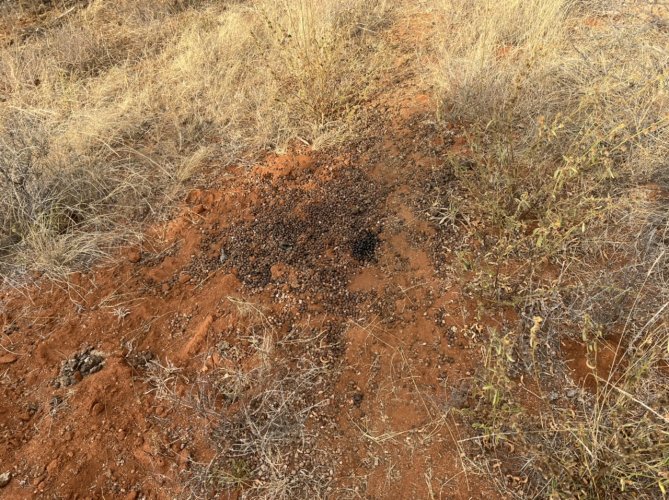
The termite mounds were scattered everywhere and you could see where anteaters had dug them out as well. I noticed one that was setup almost perfectly for a toilet and sure enough there was a pile of poop in there. I took a picture and showed Pieter and he got all excited and asked me where exactly I had taken the picture. Evidently it is a civet cat toilet and if it being used that frequently it would be a very good place to go if someone was looking to hunt a civet cat.
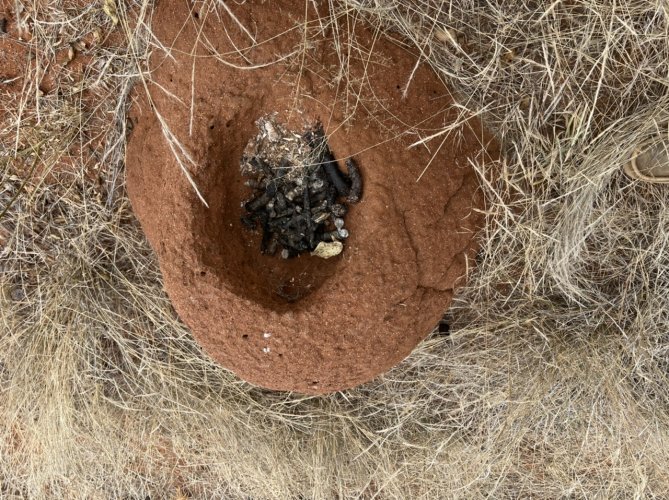
We continued tracking but the track got more and more random and finally ended up in an area with a lot of grass. I didn't realize it before, but big areas of grass are the nemesis of following the track. Not only is the track harder to spot in the grass, but when you are in really thick cover there are less places for the animal to step so finding the track is much easier. In the grassy areas the animal pretty much has unlimited places to step in any direction and the tracking gets very difficult. Pieter and Tefferi split up and make circles looking for the track and spent quite a while trying to pick it back up. Since this was the sables home territory it made it even harder because telling the difference between this mornings track and previous tracks next to impossible in the grass. They finally gave up and we started just walking through the bush hoping to possibly pick up the track again.
Eli taking a break sitting on a termite mound while waiting for them to find the track again in the grassy area.
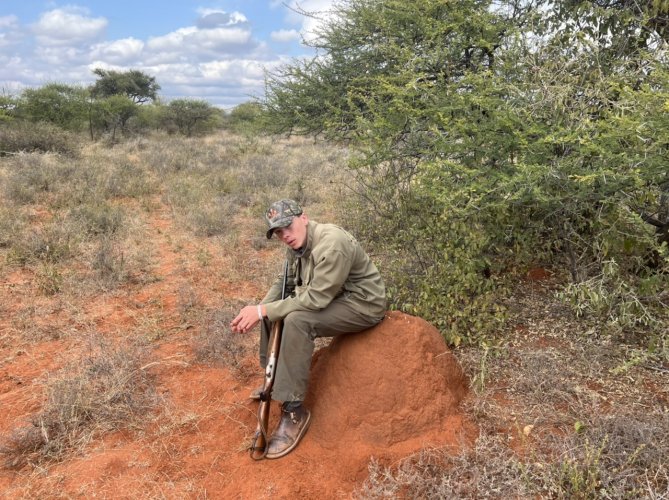
We heard the impala before we saw them. They were fighting pretty good and you could hear the horns knocking together. As we got closer they slowed down on the fighting but there was a big group of them scattered about in the brush. Some were standing and some were bedded down. We closed to within about 30 yards and somehow Pieter was able to see through all the brush and tell that one of the ones laying down was a big one.
We were down in a dry creek bed and started the waiting game. A few crawls back and forth and to the side and we got to where I could see the big one as well. The problem was that another one was laying in front of it and it was laying facing away from us. The only shot would be a neck shot but the window to hit it in the neck and not hit the other impala in front of it was pretty small. To complicate things occasionally there would be another impala move past behind them. The one laying in front was somewhat looking our direction so we had to work really hard on staying still. We were waiting on it to look away so we could get the rifle on the sticks but it never did. The big one stood up and Pieter set the sticks spread wide for a kneeling shot and I got the rifle on the sticks and got the big one in the scope just as it walked out of the window through the brush that we could see through. It all went down in probably 2 seconds and I needed 3 seconds to make it happen. We swung around hoping they would head into the creek bottom where we had an opening that we could see down, but they moved off parallel to the creek and didn't cross. We packed up and move around but just couldn't get ahead of them and they were gone.
It was now pushing 1:00 and we decided to go ahead and walk to the road and head back to the lodge for lunch. After we had lost the sable track, Pieter sent Tefferi back to the truck so a quick radio call and magically the truck shows up in just a minute or two and we head back for lunch.
Kudu was pretty much at the top of both of our lists and we had gone over our priorities with Pieter but we were still early in the hunt and we were just working through what the bush was giving us. That morning they found a very good sable track that they were pretty excited about. They had seen a very good sable in the area previously and were pretty certain this was it.
We started following the track very slowly and cautiously. Even I could tell that this was this sable's home territory and there was fresh poop everywhere and lots of tracks. They could tell from the tracks that he was just wandering around and feeding and not moving in a consistent direction so it was pretty slow going especially as there were several different sets of tracks from the same animal. How they could tell the difference between a track from that morning and a track from the night before was pretty amazing. They looked at the quality of the track and also said that you could tell by the color of the sand as well. Again we had the consistent theme of a light and variable wind. Starting out we had the wind in our favor but it had switched and now it wasn't exactly bad but not really good either. It was very light so we continued on.
One thing that I wasn't really expecting was the communal toilets scattered around. Impala seemed to be the most prevalent, but that is probably due to them being the largest number of animals, but it seemed that the animals tended to all use the same spots to poop.

The termite mounds were scattered everywhere and you could see where anteaters had dug them out as well. I noticed one that was setup almost perfectly for a toilet and sure enough there was a pile of poop in there. I took a picture and showed Pieter and he got all excited and asked me where exactly I had taken the picture. Evidently it is a civet cat toilet and if it being used that frequently it would be a very good place to go if someone was looking to hunt a civet cat.

We continued tracking but the track got more and more random and finally ended up in an area with a lot of grass. I didn't realize it before, but big areas of grass are the nemesis of following the track. Not only is the track harder to spot in the grass, but when you are in really thick cover there are less places for the animal to step so finding the track is much easier. In the grassy areas the animal pretty much has unlimited places to step in any direction and the tracking gets very difficult. Pieter and Tefferi split up and make circles looking for the track and spent quite a while trying to pick it back up. Since this was the sables home territory it made it even harder because telling the difference between this mornings track and previous tracks next to impossible in the grass. They finally gave up and we started just walking through the bush hoping to possibly pick up the track again.
Eli taking a break sitting on a termite mound while waiting for them to find the track again in the grassy area.

We heard the impala before we saw them. They were fighting pretty good and you could hear the horns knocking together. As we got closer they slowed down on the fighting but there was a big group of them scattered about in the brush. Some were standing and some were bedded down. We closed to within about 30 yards and somehow Pieter was able to see through all the brush and tell that one of the ones laying down was a big one.
We were down in a dry creek bed and started the waiting game. A few crawls back and forth and to the side and we got to where I could see the big one as well. The problem was that another one was laying in front of it and it was laying facing away from us. The only shot would be a neck shot but the window to hit it in the neck and not hit the other impala in front of it was pretty small. To complicate things occasionally there would be another impala move past behind them. The one laying in front was somewhat looking our direction so we had to work really hard on staying still. We were waiting on it to look away so we could get the rifle on the sticks but it never did. The big one stood up and Pieter set the sticks spread wide for a kneeling shot and I got the rifle on the sticks and got the big one in the scope just as it walked out of the window through the brush that we could see through. It all went down in probably 2 seconds and I needed 3 seconds to make it happen. We swung around hoping they would head into the creek bottom where we had an opening that we could see down, but they moved off parallel to the creek and didn't cross. We packed up and move around but just couldn't get ahead of them and they were gone.
It was now pushing 1:00 and we decided to go ahead and walk to the road and head back to the lodge for lunch. After we had lost the sable track, Pieter sent Tefferi back to the truck so a quick radio call and magically the truck shows up in just a minute or two and we head back for lunch.
Last edited:
npaden
Well-known member
Lunch was quick and we decided to go ahead and head right back out instead of taking a break like we had on previous days. We spotted a good group of impalas on the way back out and Pieter said there was a giant in the group. Maybe not getting a shot off on the big one this morning was going to work out after all. We checked the wind and felt good about our intended direction to follow them and headed off parallel to where they were headed. The brush was thick and occasionally we could catch a glimpse of a patch of brown or a leg but not much else. This is where it really sunk in just how wary these animals are. We were still working parallel to them and still just occasionally catching a glimpse of them. They are behind brush and we are behind and in front of brush, it's not like we are walking down the road out in the open. We are moving very slow and quietly and Pieter gives me the hand signal to stay still. I'm in mid step and there is brush to my left, so I finish putting my foot down and shift my weight to the left to be closer to the brush and ahead of us the brush explodes with impalas running off. All I could see were some legs when I finished putting my foot down it is unbelievable that they could even see me let alone be afraid enough to bust out like that. Pieter said that generally when he signals the stay still sign it is because he sees one of the animals looking our direction. Even then I would have thought that I could get away with putting my foot down and leaning a little to the left but evidently not. For once the wind wasn't the culprit, I was because I moved a whopping 6" to the left. A big part of this is because the brush being so thick we are having to get so close to see anything and when we are that close there is zero room for error with the wind, with sound or with movement.
We go back out to the road and head out again. Not very far at all and there is another group of impala and one of them is a big one. We see a giraffe and know that we will have to be careful not to get busted by it but go ahead and get out and plan a stalk. Eli gets out with us this time just in case we see something on his list. There is a waterhole about 3/4 of a mile away and we will work our way to it while we are on the stalk. We move toward where we saw the impala and start to skirt around the giraffe and we spot 2 more giraffes. We go to move around them and spot 2 more. Then there are 3 more where we saw the first one. Then we start to move parallel to where we wanted to go and there are even more giraffes. We are now pretty much surrounded by over a dozen giraffes all between us and where the impalas went. We try to wait them out and instead of getting better somehow even more giraffes show up. After waiting some more Pieter just decides it is pointless and he tries a gimmick that he says has worked successfully in the past where you just walk normally by the giraffes and don't make eye contact or act sneaky and they will just watch you walk by. They didn't. About 10 or 15 yards into our walk, giraffes start running away from everywhere. We start counting and end up with 20 giraffes running off. Of course the impalas that we were after join them and stay mingled in with the giraffes so attempting to continue after them is pretty much pointless.
We angle off back in the direction we intended to go from the start and head to the waterhole. The animals are always wary, but they are exceptionally wary at the waterholes. We slow down to a snails pace as we get about 400 yards away and start inching our way closer on slow step at a time. We work on staying in cover but it gets a little spotty the closer we get. The grass is completely gone around the waterholes and it is just bare dirt for probably 200 yards all around them since there are so many animals coming and going from them. Pieter spots some kudu and they are bulls and at least one of them is a big one. He checks to see which of us is going to be on the trigger and I let Eli have the first chance. It seemed like this was going to be a really good chance and I was hoping it would work out for him. I started to hang back about 20 or 30 yards while Pieter and Eli worked their way forward. Eli was getting a great education on hunting skills this entire trip and was doing a good job following Pieter and staying quiet. At one point Pieter was ducking to stay low and hide and not ducking to look under the brush and Eli didn't pick up on that and was standing straight up and down and Pieter gave him a pretty good stink eye and Eli finally figured it out and ducked down low. They were now crawling and the sticks were setup spread out about as wide as they could go and Eli was on the sticks in a sitting position. I'm about 30 yards behind them still and can't really tell what is going on, but it seems like they are having a hard time getting Eli lined up on the kudu. They move a couple times and I hear Pieter tell Eli to shoot and nothing happens. You can tell that Pieter is getting a little frustrated and they move again but now it seems like the kudu are back on the move. They move forward about 30 yards to a different tree and setup again. I spot a glimpse of a kudu leaving off to the right but they seem focused on the left but I can't see anything. After a few more minutes they stand up and move toward the waterhole again. I catch up with them and the kudu are all gone.
Evidently when they were struggling to get lined up the problem was that there were 5 bulls with 3 being smaller and 2 big ones. The small ones were always in front of the big ones and there never was an open shot. After they moved over the small bulls finally cleared off and moved off to the right and the biggest bull was open and that's when Pieter told Eli to shoot, but there was a leaf in the way of the scope and Eli didn't have a clear shot. Eli didn't communicate that so that's when Pieter got frustrated. We missed out on a great opportunity at a big kudu bull, but as we debriefed and talked Eli through what he should have done differently if he couldn't see clearly and how he could communicate that to Pieter. Even though we missed the opportunity at the kudu I think that this was a great learning experience for Eli. The entire trip was a learning experience for him and I think he got about 10 years worth of hunting experience crammed into a little over a week that we were there. Lots of quick decisions that had to be made, learned a lot about walking quietly and staying still. Hopefully it pays dividends down the road as a boost to his hunting abilities.
We go back out to the road and head out again. Not very far at all and there is another group of impala and one of them is a big one. We see a giraffe and know that we will have to be careful not to get busted by it but go ahead and get out and plan a stalk. Eli gets out with us this time just in case we see something on his list. There is a waterhole about 3/4 of a mile away and we will work our way to it while we are on the stalk. We move toward where we saw the impala and start to skirt around the giraffe and we spot 2 more giraffes. We go to move around them and spot 2 more. Then there are 3 more where we saw the first one. Then we start to move parallel to where we wanted to go and there are even more giraffes. We are now pretty much surrounded by over a dozen giraffes all between us and where the impalas went. We try to wait them out and instead of getting better somehow even more giraffes show up. After waiting some more Pieter just decides it is pointless and he tries a gimmick that he says has worked successfully in the past where you just walk normally by the giraffes and don't make eye contact or act sneaky and they will just watch you walk by. They didn't. About 10 or 15 yards into our walk, giraffes start running away from everywhere. We start counting and end up with 20 giraffes running off. Of course the impalas that we were after join them and stay mingled in with the giraffes so attempting to continue after them is pretty much pointless.
We angle off back in the direction we intended to go from the start and head to the waterhole. The animals are always wary, but they are exceptionally wary at the waterholes. We slow down to a snails pace as we get about 400 yards away and start inching our way closer on slow step at a time. We work on staying in cover but it gets a little spotty the closer we get. The grass is completely gone around the waterholes and it is just bare dirt for probably 200 yards all around them since there are so many animals coming and going from them. Pieter spots some kudu and they are bulls and at least one of them is a big one. He checks to see which of us is going to be on the trigger and I let Eli have the first chance. It seemed like this was going to be a really good chance and I was hoping it would work out for him. I started to hang back about 20 or 30 yards while Pieter and Eli worked their way forward. Eli was getting a great education on hunting skills this entire trip and was doing a good job following Pieter and staying quiet. At one point Pieter was ducking to stay low and hide and not ducking to look under the brush and Eli didn't pick up on that and was standing straight up and down and Pieter gave him a pretty good stink eye and Eli finally figured it out and ducked down low. They were now crawling and the sticks were setup spread out about as wide as they could go and Eli was on the sticks in a sitting position. I'm about 30 yards behind them still and can't really tell what is going on, but it seems like they are having a hard time getting Eli lined up on the kudu. They move a couple times and I hear Pieter tell Eli to shoot and nothing happens. You can tell that Pieter is getting a little frustrated and they move again but now it seems like the kudu are back on the move. They move forward about 30 yards to a different tree and setup again. I spot a glimpse of a kudu leaving off to the right but they seem focused on the left but I can't see anything. After a few more minutes they stand up and move toward the waterhole again. I catch up with them and the kudu are all gone.
Evidently when they were struggling to get lined up the problem was that there were 5 bulls with 3 being smaller and 2 big ones. The small ones were always in front of the big ones and there never was an open shot. After they moved over the small bulls finally cleared off and moved off to the right and the biggest bull was open and that's when Pieter told Eli to shoot, but there was a leaf in the way of the scope and Eli didn't have a clear shot. Eli didn't communicate that so that's when Pieter got frustrated. We missed out on a great opportunity at a big kudu bull, but as we debriefed and talked Eli through what he should have done differently if he couldn't see clearly and how he could communicate that to Pieter. Even though we missed the opportunity at the kudu I think that this was a great learning experience for Eli. The entire trip was a learning experience for him and I think he got about 10 years worth of hunting experience crammed into a little over a week that we were there. Lots of quick decisions that had to be made, learned a lot about walking quietly and staying still. Hopefully it pays dividends down the road as a boost to his hunting abilities.
npaden
Well-known member
Okay back to the hunt. We walked around the waterhole a little, while we were putting the stalk on the kudu, two small warthogs had gone past me at about 25 yards going to the waterhole but there was no sign of them now. There was a pretty sketchy blind setup over the water and Eli asked if it was safe and Pieter replied that as sketchy as it looked it was actually a pretty solid setup. We radioed for the truck and when they got to us they told us that they had seen some zebra and some buffalo as well about 30 minutes ago and had thought they were headed our way but they never showed up.
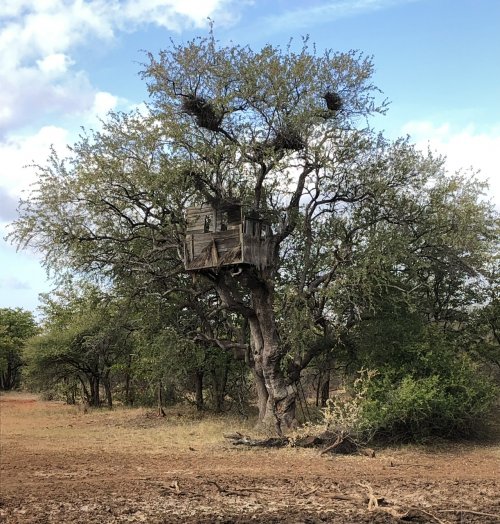
Buffalo were not on either of our lists, but you could tell that Pieter had a spot on his list for them. We drove back to where they said they saw them and looked at the tracks for a bit and discussed where they were going, etc. We decided that both the buffalo and zebra were probably not going to be very cooperative and it was starting to get late so we drove on. We spot some promising kudu tracks crossing the road but the wind is wrong so we drop Tefferi off at the 3 way intersection so he can let us know if anything crosses the road and then we drive all the way around in a big square probably 2 or 3 miles to get to the other side with the wind blowing right for us. We park and as we are getting out of the truck a herd of zebra comes out of the brush a couple hundred yards away in a big open spot and they are headed right toward us. We still don't know the status of Eli's zebra so I get on the sticks and work on getting lined up on one. There is a small one in the scope first and Pieter says not to shoot that one and I move left and then right and the zebras are all moving pretty fast and before you know it they are basically on top of us now pretty much at a full run. They go by about 50 yards to the side of us and we grab the sticks and move to the other road and throw the sticks up as the zebra start running past. Teferri is standing in the middle of this road about 1/2 mile away at the 3 way intersection and the zebra are running by very fast. Pieter radios for Teferri to get out of the road, but there just isn't a shot anyway with the zebra pretty much at full speed. The excitement dies down and I feel a little bad for not shooting but there just wasn't a clean shot and they were moving pretty good the entire time.
We decided to go ahead and try to intercept the kudu that we had seen the tracks crossing the road and the zebra had gone that direction as well and the wind was still good so we headed off in that direction. The zebra tracks were pretty obvious and we ended up finding some kudu tracks but they were already passed where we wanted them to be and the wind was wrong to try to follow them. We ended up following the zebra tracks a while and they turned back the other direction. We followed them a ways then broke off when we crossed a kudu track going the other direction. We crossed the road and were moving through the bush when out of no where a big kudu bull ran off maybe 30 yards ahead of us. Pieter was kicking himself for not slowing down and getting busted, but none of us really even knew he was there. According to Pieter he was a big one, Eli saw the horns as well and said he was but I never even got a glimpse of the horns from 30 yards away.
We end up moving slowly back through the bush toward the truck and it is now getting pretty dark. We load up and start driving maybe 100 yards and Pieter spots kudu and zebra ahead of us in the road. We pull off really quick and shut the truck off and get the sticks out. We move to the road and he sets the sticks up and the kudu are gone but the zebra are ahead of us in the road walking straight away several hundred yards ahead. We head out on an intercept angle through the bush and we are fighting the clock as darkness is really getting close. A few hundred yards ahead and we spot the zebra moving right to left ahead of us in and out of the brush. We angle farther to the left and work on intercepting them and getting a little closer. Pieter sets up the sticks and tells me to shot that zebra right in the chest. I get on the sticks and can only see one zebra and it is looking straight at us maybe 75 or 100 yards away. I can't even see it's head, just it's chest and legs but I line up and pull the trigger. The zebra drops on the spot and is done. No tracking job will be needed on this one and it is a good thing because it is getting dark. Eli said he could see flames shoot out of the barrel of the gun about 10 feet when I shot.
We move up to the zebra cautiously but it is already dead. It is a nice stallion and it amazes me that Pieter was able to judge that it was a stallion when I could barely make out that it was a zebra. We quickly set it up to take some pictures but I thought it was probably a waste as it was already too dark to take good pictures, but surprisingly my iphone13 pro did a really good job in the low light conditions. As it got too dark either Pieter changed the settings or it automatically set the exposure to a timer where it held the shutter open extra long to get a good exposure. You had to hold still but it really ended up with some good pictures for how dark it was.
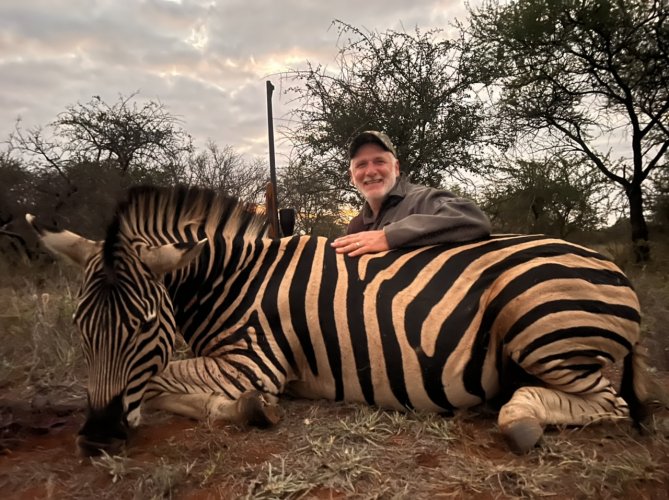
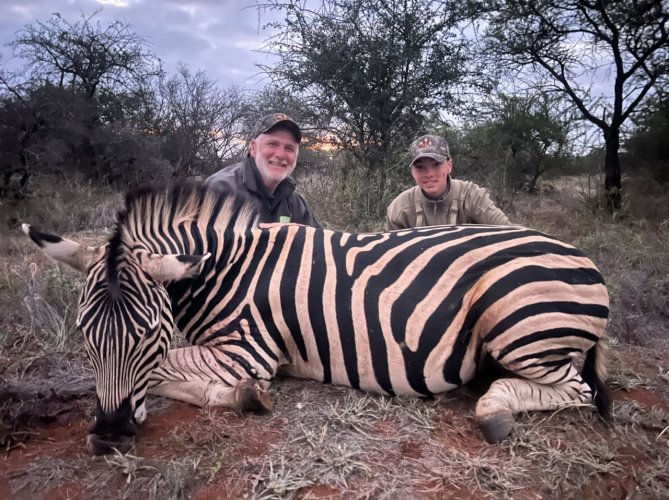
After some quick pictures, Pieter headed off in the dark to get the truck and come load up the zebra. Somewhere in there they collected Tefferi as well but it was a good 30 or 40 minutes before they got back with the truck. For recovering animals they don't worry about roads, just drive through the brush and dodge trees to get where they need to go. We did the winch trick again to load the zebra and some careful driving had us back on the road and headed to the lodge. The trackers live where the skinning shed is so they would just take the truck and zebra to the skinning shed after they dropped us off at the lodge since it was on the way.
Dinner that night was wildebeest tenderloin with some kind of a breading and some potatoes and green beans wrapped with bacon. The wildebeest was very good and it was odd to have breading on a tenderloin but it was excellent.
Dinner conversations were amazing as Pieter's wife would join us and they have some amazing stories to tell. She has an especially soft heart for orphaned animals and tales of a pet mongoose and a baby cape buffalo in their house had us laughing so hard we were almost crying.
VERY happy to have another animal on the ground and recovered, we started the day on a high note and ended it on a high note. We are still way behind on getting our list completed but we are finally seeming to be making some progress anyway.
Day 4 ended with only 5 miles walked. It didn't seem like we were that much shorter than the other days but thinking back on it we really weren't ever just walking, we were always moving very slow on a stalk. Again, the moving time might be a better indicator but I don't have that stat available.

Buffalo were not on either of our lists, but you could tell that Pieter had a spot on his list for them. We drove back to where they said they saw them and looked at the tracks for a bit and discussed where they were going, etc. We decided that both the buffalo and zebra were probably not going to be very cooperative and it was starting to get late so we drove on. We spot some promising kudu tracks crossing the road but the wind is wrong so we drop Tefferi off at the 3 way intersection so he can let us know if anything crosses the road and then we drive all the way around in a big square probably 2 or 3 miles to get to the other side with the wind blowing right for us. We park and as we are getting out of the truck a herd of zebra comes out of the brush a couple hundred yards away in a big open spot and they are headed right toward us. We still don't know the status of Eli's zebra so I get on the sticks and work on getting lined up on one. There is a small one in the scope first and Pieter says not to shoot that one and I move left and then right and the zebras are all moving pretty fast and before you know it they are basically on top of us now pretty much at a full run. They go by about 50 yards to the side of us and we grab the sticks and move to the other road and throw the sticks up as the zebra start running past. Teferri is standing in the middle of this road about 1/2 mile away at the 3 way intersection and the zebra are running by very fast. Pieter radios for Teferri to get out of the road, but there just isn't a shot anyway with the zebra pretty much at full speed. The excitement dies down and I feel a little bad for not shooting but there just wasn't a clean shot and they were moving pretty good the entire time.
We decided to go ahead and try to intercept the kudu that we had seen the tracks crossing the road and the zebra had gone that direction as well and the wind was still good so we headed off in that direction. The zebra tracks were pretty obvious and we ended up finding some kudu tracks but they were already passed where we wanted them to be and the wind was wrong to try to follow them. We ended up following the zebra tracks a while and they turned back the other direction. We followed them a ways then broke off when we crossed a kudu track going the other direction. We crossed the road and were moving through the bush when out of no where a big kudu bull ran off maybe 30 yards ahead of us. Pieter was kicking himself for not slowing down and getting busted, but none of us really even knew he was there. According to Pieter he was a big one, Eli saw the horns as well and said he was but I never even got a glimpse of the horns from 30 yards away.
We end up moving slowly back through the bush toward the truck and it is now getting pretty dark. We load up and start driving maybe 100 yards and Pieter spots kudu and zebra ahead of us in the road. We pull off really quick and shut the truck off and get the sticks out. We move to the road and he sets the sticks up and the kudu are gone but the zebra are ahead of us in the road walking straight away several hundred yards ahead. We head out on an intercept angle through the bush and we are fighting the clock as darkness is really getting close. A few hundred yards ahead and we spot the zebra moving right to left ahead of us in and out of the brush. We angle farther to the left and work on intercepting them and getting a little closer. Pieter sets up the sticks and tells me to shot that zebra right in the chest. I get on the sticks and can only see one zebra and it is looking straight at us maybe 75 or 100 yards away. I can't even see it's head, just it's chest and legs but I line up and pull the trigger. The zebra drops on the spot and is done. No tracking job will be needed on this one and it is a good thing because it is getting dark. Eli said he could see flames shoot out of the barrel of the gun about 10 feet when I shot.
We move up to the zebra cautiously but it is already dead. It is a nice stallion and it amazes me that Pieter was able to judge that it was a stallion when I could barely make out that it was a zebra. We quickly set it up to take some pictures but I thought it was probably a waste as it was already too dark to take good pictures, but surprisingly my iphone13 pro did a really good job in the low light conditions. As it got too dark either Pieter changed the settings or it automatically set the exposure to a timer where it held the shutter open extra long to get a good exposure. You had to hold still but it really ended up with some good pictures for how dark it was.


After some quick pictures, Pieter headed off in the dark to get the truck and come load up the zebra. Somewhere in there they collected Tefferi as well but it was a good 30 or 40 minutes before they got back with the truck. For recovering animals they don't worry about roads, just drive through the brush and dodge trees to get where they need to go. We did the winch trick again to load the zebra and some careful driving had us back on the road and headed to the lodge. The trackers live where the skinning shed is so they would just take the truck and zebra to the skinning shed after they dropped us off at the lodge since it was on the way.
Dinner that night was wildebeest tenderloin with some kind of a breading and some potatoes and green beans wrapped with bacon. The wildebeest was very good and it was odd to have breading on a tenderloin but it was excellent.
Dinner conversations were amazing as Pieter's wife would join us and they have some amazing stories to tell. She has an especially soft heart for orphaned animals and tales of a pet mongoose and a baby cape buffalo in their house had us laughing so hard we were almost crying.
VERY happy to have another animal on the ground and recovered, we started the day on a high note and ended it on a high note. We are still way behind on getting our list completed but we are finally seeming to be making some progress anyway.
Day 4 ended with only 5 miles walked. It didn't seem like we were that much shorter than the other days but thinking back on it we really weren't ever just walking, we were always moving very slow on a stalk. Again, the moving time might be a better indicator but I don't have that stat available.
Last edited:
npaden
Well-known member
Before dinner we talked with Jewel who had tracked the zebra that Eli shot all day. When he got on the track that morning he could see where a hyena had chased it during the night and after the hyena some jackals had chased it. He continued to follow the track although again it intermingled with other zebra and got very difficult to keep up with which track was which. He kept after it and felt like he was still on the track and then a leopard started following the track as well and the zebra ran and again mixed up with other running zebra tracks.
We discussed the potential for finding it and picking up the track again and we were all perplexed. This entire time we were expecting to find a dead zebra, just expected it to take a while to die. Something isn't adding up as it is still healthy enough to be running from a leopard over 48 hours after the shot.
We decided to mark it down as lost and not continue to look for it. It was a tough decision but the tracker hadn't seen a drop of blood in a day and a half and it wasn't looking like it was slowing down at all. We still had to pay for it since he drew blood but it really seemed like there may have been a deflection on the shot or something and continuing to track it didn't seem like it was worthwhile.
Pieter said that if they end up shooting and recovering a zebra sometime down the road that has an obvious bullet wound that he will give us credit back for it. I'm not that worried about the money, just wanted to give a 100% effort on recovering it and I think tracking it for 2 1/2 days qualifies as 100% effort.
We discussed the potential for finding it and picking up the track again and we were all perplexed. This entire time we were expecting to find a dead zebra, just expected it to take a while to die. Something isn't adding up as it is still healthy enough to be running from a leopard over 48 hours after the shot.
We decided to mark it down as lost and not continue to look for it. It was a tough decision but the tracker hadn't seen a drop of blood in a day and a half and it wasn't looking like it was slowing down at all. We still had to pay for it since he drew blood but it really seemed like there may have been a deflection on the shot or something and continuing to track it didn't seem like it was worthwhile.
Pieter said that if they end up shooting and recovering a zebra sometime down the road that has an obvious bullet wound that he will give us credit back for it. I'm not that worried about the money, just wanted to give a 100% effort on recovering it and I think tracking it for 2 1/2 days qualifies as 100% effort.
Salmonchaser
Well-known member
- Joined
- Nov 12, 2019
- Messages
- 2,601
Great write up, zebra appear tough. Reads as though you're having a great adventure.
npaden
Well-known member
Okay, on to day 5! I had some rough notes but I'm remembering quite a bit of the details as I go back and type this up. I also took quite a few pictures and it helps to go back and look at those and the timestamps on them to help me piece everything together. If someone is looking for a brief summary they are reading the wrong posts!
Day 5 broke cold and rainy. The temperatures so far had been in the low 50's each morning generally warming to the mid 80's in the afternoon. This is winter for them and it was interesting to see the trackers with 3 shirts, 2 jackets, gloves and a toboggan on to start the day and by the time we were down to just a short sleeve shirt in the afternoon they still had 3 shirts layered on. The wind was blowing steady and a light rain was coming off and on. Cathy made a poor decision and decided to come with us and in retrospect she wished she had stayed back at the lodge.
Pieter was excited about the steady wind. He said that gave us a big advantage both in scent and sound and he felt we were going to have a good day. The negative thing was that because it was cold the animals wouldn't be moving around as much so it would be tougher to spot them. The wind wasn't really that strong, less than 15 mph which wouldn't be considered very strong most places but after 4 days of light and variable winds that were constantly shifting, we were happy with it. We discussed that back home on an overcast day like this the animals would most likely be out and about, but he said that there the animals seemed to prefer the warm sunny days instead.
Kudu was the target this morning and we drove around looking for tracks. Since Jewel was off the zebra track, he rode on the front bumper looking for tracks in the road while Tefferi rode in the back.
I forgot to mention that Cathy was sad that the boys were back in school and not able to go out with us anymore. They had been great company at the truck and had explained to her the different sounds that went with each of the animals and explained the different tracks and birds. They had a book with all the tracks, birds, animals, etc. in the truck that was helpful as well.
We came on a VERY fresh leopard track and we stopped the truck and we all got out an looked at it. Pretty neat to see, no doubt about the track and it was very fresh.
Continued driving, it was a bit hard to stay focused with the rain. It wasn't a hard rain but trying to spot game from the truck while it was moving hurt your eyes as the rain hit them. We developed a sideways type style to block the rain from our eyes but still at least attempt to spot things. I wasn't sure how Jewel was doing it on the front bumper and he was wearing a tobaggan, not a cap with a brim. We ended up driving over the the western boundary of the property and spotted some impala here and there. Nothing that interested Pieter enough to get off the truck and go after though. Somewhere in there we start hearing a woosh whoosh sound like something is stuck to one of the tires. Tefferi gets of and listens as they slowly drive forward the spare tire that is on there from the other day now has a hole in it. We are close to another lodge that they have that is setup pretty much like a dormitory style with probably 20 beds in it and park under an awning while they change the tire. Pieter goes out looking for tracks while Jewel and Tefferi change the tire. We went in the lodge and it was a pretty neat setup. This was where Pieter lived before he got married and for the first few years after he got married. Several of the stories we had heard over dinners centered around this place so it was neat to see it in person. Lots of neat taxidermy as well but we forgot to take any pictures.
After the tire was changed we went and found Pieter. No interesting tracks so we continued to drive. Much as Pieter had predicted there just didn't seem to be many animals out and about, they must all be hunkered down somewhere. We did spot some impalas intermingled with some giraffes but didn't see a good ram in the mix so didn't go after them. After a while we finally spot a group of impala with a good ram and go after them. The wind is good but sure enough we end up with a group of giraffes between us and the impalas. Giraffes can make quite a bit of racket with they run off and when they ran some zebras that we hadn't even noticed ran off with them. Needless to say the impalas were gone as well.
One interesting thing on this stalk was that when the giraffes ran off one of the baby giraffes didn't go with them but hang around checking us out. A "baby" giraffe is still probably 9 or 10 feet tall and probably weighs 1,000+ pounds but it was obviously a young one. Probably a male since it seemed pretty stupid. We ended up walking by about 10 or 15 yards from it as it stood there and watched us. Of course I didn't think to take a picture of it but Eli did. His phone camera isn't as good as mine so the picture quality isn't great but hopefully you can get an idea of how close it was to us. I have some other pictures of giraffes that are probably just as close but those were taken from the truck. With Pieter's strict policy of no shooting from the truck the animals aren't nearly as afraid of the truck as they are of people on foot. This was by far the closest that we got to a giraffe while out walking.
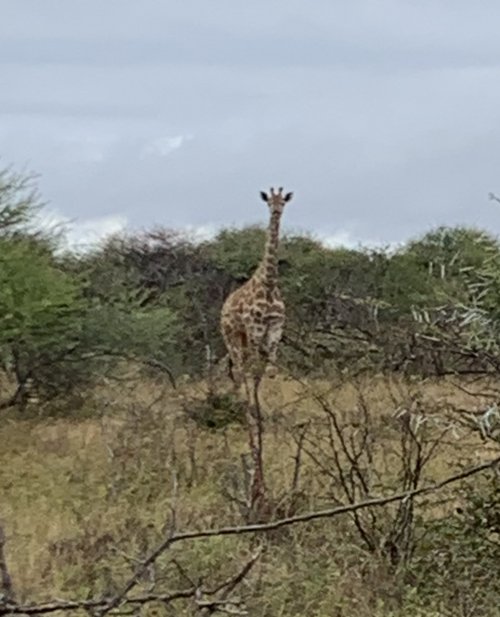
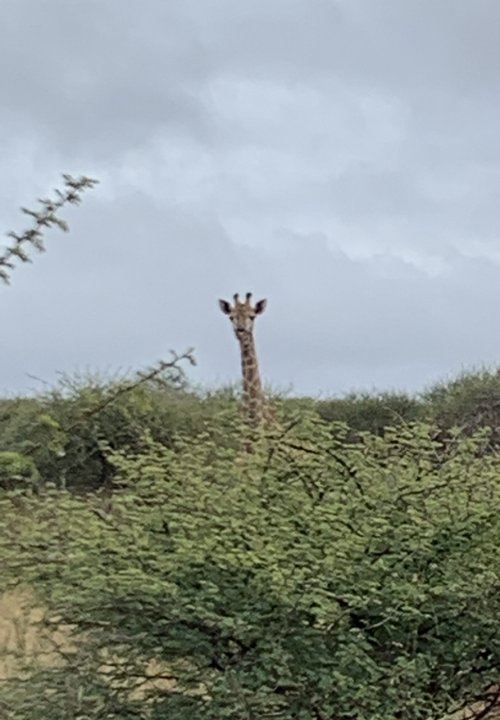
We got back to the truck and headed off again. We had seen a few kudu tracks but evidently nothing that Pieter thought was worth going after. Either they were headed the wrong direction based on the wind or they weren't big enough. I've never been a big believer that you can really tell much about the size of an animal based on the track and for the most part these African animals have MUCH smaller feet than you would expect so telling the difference between a big kudu track and a small kudu track seems like it would be difficult, but they were very confident when they saw a track as to whether the animal that left it was big or not. We did end up seeing a some roan which as neat, they are a very pretty animal but to a layperson they would just think they were a small sable so it seems crazy that you would want to spend considerably more to shoot a roan than to shoot a sable that looks similar but is much bigger and I think prettier. Oh well, the rain had stopped and it seemed like things were getting out and moving now anyway.
We spot a very big group of impala walking right down the road and are able to stop and look at them pretty well. There are several big ones and a few big big ones and maybe even one or two giant ones in this group. The wind is wrong for a stalk so we just continue past them in the truck and go on by 500 or 600 yards and unload. The impala all cleared off as we drove past but the two biggest ones ended up on the opposite side of the road as the bigger group so we move quickly to try to get setup on them expecting them to want to come back across the road.
We move parallel to the road through the brush for a couple hundred yards and then move back to the road for a look. Pieter sets me up on the sticks looking down the road but nothing ever shows up. We pull back and move on a intercept course for the bigger group with a steady wind in our favor for once. We move super slow and with extreme patience. Sometimes we stand for 4 or 5 minutes with Pieter looking through his binoculars into the brush (8x32 Swarovskis which seem perfectly suited for this type of hunting). We literally take an hour to cover about 400 yards. Every once in a while we could catch a glimpse of brown or a leg through the brush. We could hear them several times vocalizing. I would have never expected the sound that they make to come from one of them. The rams make a noise that sounds like a pig oinking. This should not be the rut at all for impala but it has been a very weird year with all the moisture they have had and Pieter wasn't sure if possibly a few of the ewes that hadn't been pregnant were going into heat or exactly what was going on but there were rams fighting and roaring a few times while we were stalking them throughout the week.
Patience paid off this time and somehow Pieter was able to verify that the ram barely even visible through the brush about 60 yards away was a good one and setup the sticks and told me to shoot. I felt good on the sticks and squeezed the trigger and he maybe went 5 yards and was down. Another sigh of relief that there was not going to be any tracking needed. My shot ended up being a little low and forward but broke both legs and hit lungs and possibly heart so it worked out pretty well.
Pieter headed for the truck while we waited. I joked that I could carry him on my shoulders to the road but he said he would get the truck. It seemed to take longer than I would have expected to get the truck and we never did hear it and then the dogs came running up with Pieter, Jewel and Tefferi close behind. We took the field photos and then Pieter asked if I wanted the skin or not and I said just the skull and you could see a little relief on Jewel and Tefferi's faces. Since I didn't want the skin they were able to drag it the 200 yards or so to where the truck was parked and if I had wanted the skin they would have had to carry it. Impalas aren't big but carrying one through the bush would have been a bit more effort than just dragging it.
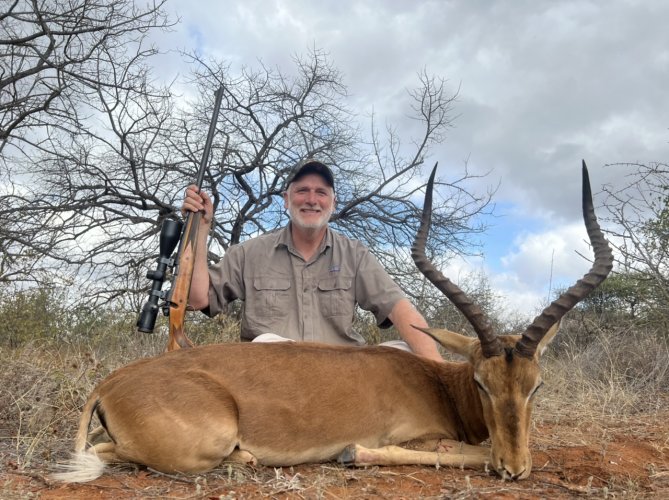
This impala was an old warrior. It's left ear was split nearly completely in two and it had several scars on it's neck from fighting.
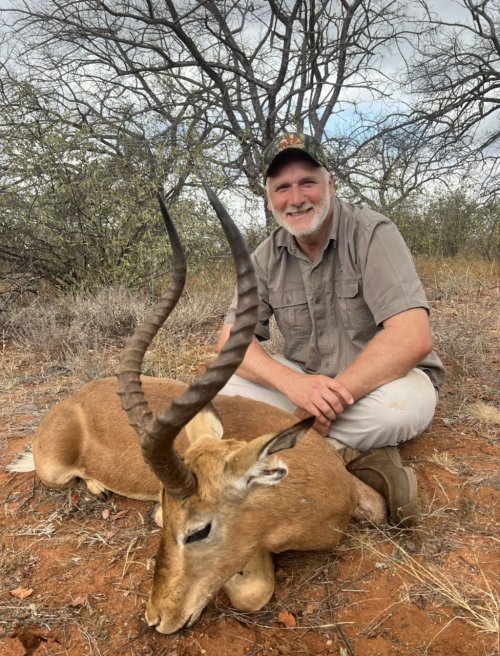
Day 5 broke cold and rainy. The temperatures so far had been in the low 50's each morning generally warming to the mid 80's in the afternoon. This is winter for them and it was interesting to see the trackers with 3 shirts, 2 jackets, gloves and a toboggan on to start the day and by the time we were down to just a short sleeve shirt in the afternoon they still had 3 shirts layered on. The wind was blowing steady and a light rain was coming off and on. Cathy made a poor decision and decided to come with us and in retrospect she wished she had stayed back at the lodge.
Pieter was excited about the steady wind. He said that gave us a big advantage both in scent and sound and he felt we were going to have a good day. The negative thing was that because it was cold the animals wouldn't be moving around as much so it would be tougher to spot them. The wind wasn't really that strong, less than 15 mph which wouldn't be considered very strong most places but after 4 days of light and variable winds that were constantly shifting, we were happy with it. We discussed that back home on an overcast day like this the animals would most likely be out and about, but he said that there the animals seemed to prefer the warm sunny days instead.
Kudu was the target this morning and we drove around looking for tracks. Since Jewel was off the zebra track, he rode on the front bumper looking for tracks in the road while Tefferi rode in the back.
I forgot to mention that Cathy was sad that the boys were back in school and not able to go out with us anymore. They had been great company at the truck and had explained to her the different sounds that went with each of the animals and explained the different tracks and birds. They had a book with all the tracks, birds, animals, etc. in the truck that was helpful as well.
We came on a VERY fresh leopard track and we stopped the truck and we all got out an looked at it. Pretty neat to see, no doubt about the track and it was very fresh.
Continued driving, it was a bit hard to stay focused with the rain. It wasn't a hard rain but trying to spot game from the truck while it was moving hurt your eyes as the rain hit them. We developed a sideways type style to block the rain from our eyes but still at least attempt to spot things. I wasn't sure how Jewel was doing it on the front bumper and he was wearing a tobaggan, not a cap with a brim. We ended up driving over the the western boundary of the property and spotted some impala here and there. Nothing that interested Pieter enough to get off the truck and go after though. Somewhere in there we start hearing a woosh whoosh sound like something is stuck to one of the tires. Tefferi gets of and listens as they slowly drive forward the spare tire that is on there from the other day now has a hole in it. We are close to another lodge that they have that is setup pretty much like a dormitory style with probably 20 beds in it and park under an awning while they change the tire. Pieter goes out looking for tracks while Jewel and Tefferi change the tire. We went in the lodge and it was a pretty neat setup. This was where Pieter lived before he got married and for the first few years after he got married. Several of the stories we had heard over dinners centered around this place so it was neat to see it in person. Lots of neat taxidermy as well but we forgot to take any pictures.
After the tire was changed we went and found Pieter. No interesting tracks so we continued to drive. Much as Pieter had predicted there just didn't seem to be many animals out and about, they must all be hunkered down somewhere. We did spot some impalas intermingled with some giraffes but didn't see a good ram in the mix so didn't go after them. After a while we finally spot a group of impala with a good ram and go after them. The wind is good but sure enough we end up with a group of giraffes between us and the impalas. Giraffes can make quite a bit of racket with they run off and when they ran some zebras that we hadn't even noticed ran off with them. Needless to say the impalas were gone as well.
One interesting thing on this stalk was that when the giraffes ran off one of the baby giraffes didn't go with them but hang around checking us out. A "baby" giraffe is still probably 9 or 10 feet tall and probably weighs 1,000+ pounds but it was obviously a young one. Probably a male since it seemed pretty stupid. We ended up walking by about 10 or 15 yards from it as it stood there and watched us. Of course I didn't think to take a picture of it but Eli did. His phone camera isn't as good as mine so the picture quality isn't great but hopefully you can get an idea of how close it was to us. I have some other pictures of giraffes that are probably just as close but those were taken from the truck. With Pieter's strict policy of no shooting from the truck the animals aren't nearly as afraid of the truck as they are of people on foot. This was by far the closest that we got to a giraffe while out walking.


We got back to the truck and headed off again. We had seen a few kudu tracks but evidently nothing that Pieter thought was worth going after. Either they were headed the wrong direction based on the wind or they weren't big enough. I've never been a big believer that you can really tell much about the size of an animal based on the track and for the most part these African animals have MUCH smaller feet than you would expect so telling the difference between a big kudu track and a small kudu track seems like it would be difficult, but they were very confident when they saw a track as to whether the animal that left it was big or not. We did end up seeing a some roan which as neat, they are a very pretty animal but to a layperson they would just think they were a small sable so it seems crazy that you would want to spend considerably more to shoot a roan than to shoot a sable that looks similar but is much bigger and I think prettier. Oh well, the rain had stopped and it seemed like things were getting out and moving now anyway.
We spot a very big group of impala walking right down the road and are able to stop and look at them pretty well. There are several big ones and a few big big ones and maybe even one or two giant ones in this group. The wind is wrong for a stalk so we just continue past them in the truck and go on by 500 or 600 yards and unload. The impala all cleared off as we drove past but the two biggest ones ended up on the opposite side of the road as the bigger group so we move quickly to try to get setup on them expecting them to want to come back across the road.
We move parallel to the road through the brush for a couple hundred yards and then move back to the road for a look. Pieter sets me up on the sticks looking down the road but nothing ever shows up. We pull back and move on a intercept course for the bigger group with a steady wind in our favor for once. We move super slow and with extreme patience. Sometimes we stand for 4 or 5 minutes with Pieter looking through his binoculars into the brush (8x32 Swarovskis which seem perfectly suited for this type of hunting). We literally take an hour to cover about 400 yards. Every once in a while we could catch a glimpse of brown or a leg through the brush. We could hear them several times vocalizing. I would have never expected the sound that they make to come from one of them. The rams make a noise that sounds like a pig oinking. This should not be the rut at all for impala but it has been a very weird year with all the moisture they have had and Pieter wasn't sure if possibly a few of the ewes that hadn't been pregnant were going into heat or exactly what was going on but there were rams fighting and roaring a few times while we were stalking them throughout the week.
Patience paid off this time and somehow Pieter was able to verify that the ram barely even visible through the brush about 60 yards away was a good one and setup the sticks and told me to shoot. I felt good on the sticks and squeezed the trigger and he maybe went 5 yards and was down. Another sigh of relief that there was not going to be any tracking needed. My shot ended up being a little low and forward but broke both legs and hit lungs and possibly heart so it worked out pretty well.
Pieter headed for the truck while we waited. I joked that I could carry him on my shoulders to the road but he said he would get the truck. It seemed to take longer than I would have expected to get the truck and we never did hear it and then the dogs came running up with Pieter, Jewel and Tefferi close behind. We took the field photos and then Pieter asked if I wanted the skin or not and I said just the skull and you could see a little relief on Jewel and Tefferi's faces. Since I didn't want the skin they were able to drag it the 200 yards or so to where the truck was parked and if I had wanted the skin they would have had to carry it. Impalas aren't big but carrying one through the bush would have been a bit more effort than just dragging it.

This impala was an old warrior. It's left ear was split nearly completely in two and it had several scars on it's neck from fighting.

Last edited:
npaden
Well-known member
It was nearly 2 by the time we got back to the lodge for lunch so we set the time for 3:00 to go back out that afternoon. Again the priority was to get on some kudu tracks with the steady wind in our favor, but it just didn't work out and we ended up chasing around some zebras instead. Same story different verse but the zebras ended up mixing in with some giraffes and we couldn't maneuver around them without everything running off. We went back to the waterhole that we had seen the kudu at the previous afternoon but nothing was going on. Did see some more roan leaving the waterhole and a few warthog sows with piglets but that was about it. Spotted some more zebra heading back to the lodge as it was getting dark and shock of all shocks they were mixed in with some giraffes and a quick stalk proved pointless.
I think this was the earliest we ended up back at the lodge in the evening. We had been going pretty hard and it was actually nice to have some time to relax before dinner. We discussed bringing in another PH so that we could split up to possibly have a better chance of checking some animals off our list and Pieter started checking to see if he could line someone up.
Ended the day with 6 miles walked. Didn't seem like we had walked that far, some of those miles were very slow stalking but thinking back on it we did cover some ground trying to maneuver around the giraffes on several of the stalks that day. By the time you leave the truck, put a stalk on and then come back a mile or two goes by pretty quickly.
I think this was the earliest we ended up back at the lodge in the evening. We had been going pretty hard and it was actually nice to have some time to relax before dinner. We discussed bringing in another PH so that we could split up to possibly have a better chance of checking some animals off our list and Pieter started checking to see if he could line someone up.
Ended the day with 6 miles walked. Didn't seem like we had walked that far, some of those miles were very slow stalking but thinking back on it we did cover some ground trying to maneuver around the giraffes on several of the stalks that day. By the time you leave the truck, put a stalk on and then come back a mile or two goes by pretty quickly.
OntarioHunter
Well-known member
- Joined
- Sep 11, 2020
- Messages
- 5,998
That's a very fine impala. I would say he might even be a "monster." Definitely will make SCI book.
npaden
Well-known member
Some where in here we talked it over and decided that if we wanted to have any chance at filling most of the animals on our list that it was going to mean extending our stay and skipping our planned trip to Kruger National Park that we were going to make the last 2 days that we were there. The primary reason we had planned the Kruger excursion was for my wife and she was pretty adamant that we needed to keep hunting if we needed to. With some more arm twisting on her part we made the call and canceled the Kruger portion of our trip. They had another group who were planning on going with them to Kruger in September and this was a extra long holiday weekend with Monday and Tuesday being national holidays to they were able to transfer the deposit that they had made for us to the September group and we didn't end up having to pay any cancellation fees for that. Thinking it though it sounded like it wouldn't really be a good time to visit Kruger anyway and the crowds would be at the maximum over the long holiday weekend.
With that decision made we talked through the option we had discussed on getting another PH so we could split up and Pieter wasn't having much luck with the guys that he normally worked with. His top 3 options were all unavailable and he wasn't sure he wanted to go much further down the list for us. Not because he wasn't willing to but because he wanted to be able to guarantee the quality of the person that we would be hunting with and after those 3 guys he wasn't as familiar with some of the others. We decided we could hunt together again and he would check around a bit more and get some options for us.
Day 6 started with a little bit of an uptick on the weather. A little cloudy to start and again we had a decently consistent wind but it was supposed to clear up and warm up. It still didn't make sense to me that the animals would be on the move in the warmer weather but these are for sure different animals than what we are used to dealing with.
We head out and not too far along we cross a fresh gemsbok bull track. Gemsbok is on both of our lists and the wind is good so we offload and start on the track. Not far in and we cross some kudu bull tracks and then some more gemsbok tracks. Then some zebra tracks. This is looking promising. My memory is a little fuzzy here but I'm pretty sure we just left the .270 at the truck and Eli was carrying the .375 H&H. I'm sure the .270 would do the job on a gemsbok but with the somewhat questionable shot placement on the first two animals he shot it wouldn't hurt to go up a bit as gemsbok are pretty notorious for being hard to bring down.
We were moving pretty slow and deliberate but not catching a glimpse of anything. One thing that was interesting is that I constantly found myself looking for shed antlers that simply don't exist. There were a few dead heads and some random bones scattered around though. We saw several impala skulls and some seemed to be pretty big ones. I did take this picture of a kudu dead head that we saw.
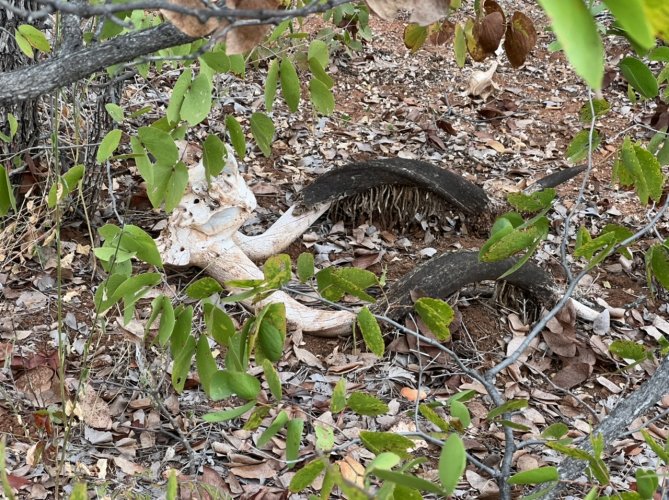
Pieter also pointed out this rub that he said was from a kudu. It looked to me like it must have gotten upset at this poor tree, it had done some pretty major damage to it. Obviously a good sized animal to do that much damage to a tree.
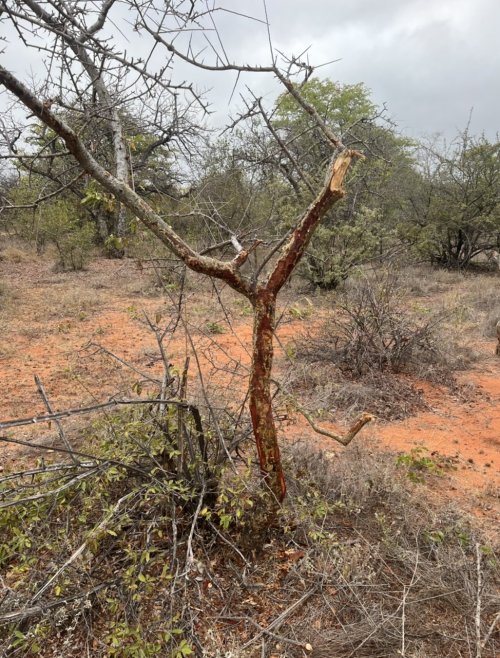
We spend probably a couple hours on the track and end up coming out maybe a mile or two and as we come out onto the road Pieter gets excited and throws the sticks up and tells Eli to shoot the gemsbok that is standing in the road. It's slightly quartering away and another one starts to come out but it was pretty clear that Pieter wanted him to shoot the first one. Eli has never shot the .375 yet but feels confident and has shouldered it and put it on the sticks a few times and is impressed with the balance and the quality of the scope so he is confident when he pulls the trigger. I am standing to the side and can't see any of this going down other than I can see Eli and the result of the shot is a very obvious hit based on the whomp when it hits the animal. Peiter tells him to shoot it again anywhere. I didn't realize it at the time but the gemsbok is now on a dead run straight away from them. Eli reloads and shoots and another whomp indicating another hit and I hear from Pieter "you dropped him".
Pieter does tell Eli that the gemsbok had been pretty cooperative and that a kudu wouldn't have hung around that long. He probably spent 15 or 20 seconds on that first shot but the second shot was quick, especially since he was running the bolt on the same side he was looking through the scope on. I was thinking the animal had just taken the hit and stood there for his follow up shot but after talking about it I was super proud of him that he was able to hit it that second time when it was on a full run. We were doing MUCH better now on eliminating the need for long tracking jobs.
We walk up to the gemsbok and determine that it is actually a her, not a him. Gemsbok females actually have longer horns than the males and this one had exceptionally long horns. Pieter said they were 40" and they also had really good mass for a cow. We set about getting setup for field photos and again I was super impressed with the quality of the photos that Pieter took for us.
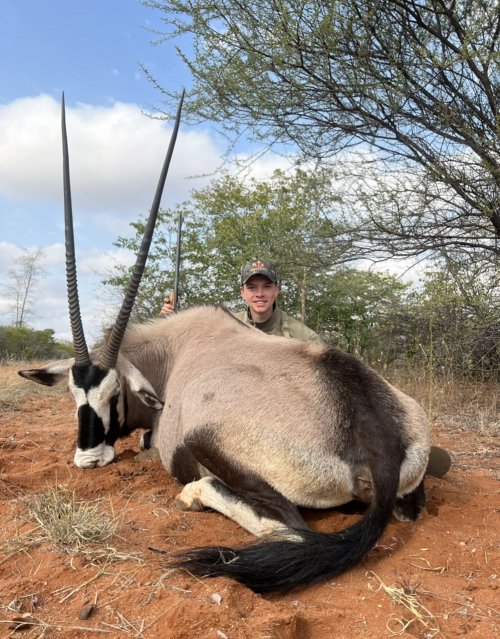
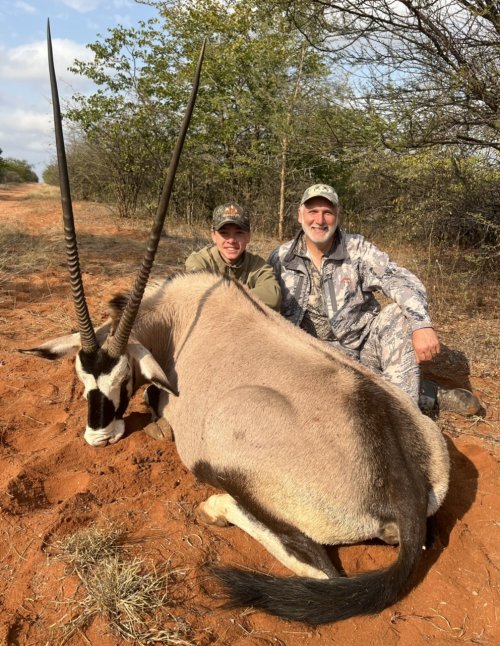
Examining the shot placement, the first shot had again hit a little farther back than the preferred placement, but on a gemsbok their lungs do go back a little farther than some of the other African animals so it probably wouldn't have been that bad of a tracking job. The second shot was through the neck but she must have been turning or something because it isn't in the back of the neck but there is a clear entry and exit hole on opposite sides of the neck. Without a doubt it dropped her though as when we walked up to her she was all tangled up from the tumble when she dropped and never moved a muscle after that.
The winch setup again worked great and we had her loaded up and headed to the skinning shed to drop her off. Eli now had 2 animals in the salt and I had 2 as well. A little behind still but it seemed like things were turning back in our favor and the animals did seem to be moving better now that the sun was shining and it was getting warmer.
Looking at the pictures made me realize that we finally had our luggage! We left the house at noon on Tuesday, arrived at Johannesburg at 6 pm on Thursday their time and got our luggage finally delivered to the lodge the next Tuesday late afternoon. The crazy thing is that we could have probably been okay without it because they had done such a good job buying and borrowing clothes for us. My wife had run out of some of her medicine though so it was good to get the luggage for that reason as well.
With that decision made we talked through the option we had discussed on getting another PH so we could split up and Pieter wasn't having much luck with the guys that he normally worked with. His top 3 options were all unavailable and he wasn't sure he wanted to go much further down the list for us. Not because he wasn't willing to but because he wanted to be able to guarantee the quality of the person that we would be hunting with and after those 3 guys he wasn't as familiar with some of the others. We decided we could hunt together again and he would check around a bit more and get some options for us.
Day 6 started with a little bit of an uptick on the weather. A little cloudy to start and again we had a decently consistent wind but it was supposed to clear up and warm up. It still didn't make sense to me that the animals would be on the move in the warmer weather but these are for sure different animals than what we are used to dealing with.
We head out and not too far along we cross a fresh gemsbok bull track. Gemsbok is on both of our lists and the wind is good so we offload and start on the track. Not far in and we cross some kudu bull tracks and then some more gemsbok tracks. Then some zebra tracks. This is looking promising. My memory is a little fuzzy here but I'm pretty sure we just left the .270 at the truck and Eli was carrying the .375 H&H. I'm sure the .270 would do the job on a gemsbok but with the somewhat questionable shot placement on the first two animals he shot it wouldn't hurt to go up a bit as gemsbok are pretty notorious for being hard to bring down.
We were moving pretty slow and deliberate but not catching a glimpse of anything. One thing that was interesting is that I constantly found myself looking for shed antlers that simply don't exist. There were a few dead heads and some random bones scattered around though. We saw several impala skulls and some seemed to be pretty big ones. I did take this picture of a kudu dead head that we saw.

Pieter also pointed out this rub that he said was from a kudu. It looked to me like it must have gotten upset at this poor tree, it had done some pretty major damage to it. Obviously a good sized animal to do that much damage to a tree.

We spend probably a couple hours on the track and end up coming out maybe a mile or two and as we come out onto the road Pieter gets excited and throws the sticks up and tells Eli to shoot the gemsbok that is standing in the road. It's slightly quartering away and another one starts to come out but it was pretty clear that Pieter wanted him to shoot the first one. Eli has never shot the .375 yet but feels confident and has shouldered it and put it on the sticks a few times and is impressed with the balance and the quality of the scope so he is confident when he pulls the trigger. I am standing to the side and can't see any of this going down other than I can see Eli and the result of the shot is a very obvious hit based on the whomp when it hits the animal. Peiter tells him to shoot it again anywhere. I didn't realize it at the time but the gemsbok is now on a dead run straight away from them. Eli reloads and shoots and another whomp indicating another hit and I hear from Pieter "you dropped him".
Pieter does tell Eli that the gemsbok had been pretty cooperative and that a kudu wouldn't have hung around that long. He probably spent 15 or 20 seconds on that first shot but the second shot was quick, especially since he was running the bolt on the same side he was looking through the scope on. I was thinking the animal had just taken the hit and stood there for his follow up shot but after talking about it I was super proud of him that he was able to hit it that second time when it was on a full run. We were doing MUCH better now on eliminating the need for long tracking jobs.
We walk up to the gemsbok and determine that it is actually a her, not a him. Gemsbok females actually have longer horns than the males and this one had exceptionally long horns. Pieter said they were 40" and they also had really good mass for a cow. We set about getting setup for field photos and again I was super impressed with the quality of the photos that Pieter took for us.


Examining the shot placement, the first shot had again hit a little farther back than the preferred placement, but on a gemsbok their lungs do go back a little farther than some of the other African animals so it probably wouldn't have been that bad of a tracking job. The second shot was through the neck but she must have been turning or something because it isn't in the back of the neck but there is a clear entry and exit hole on opposite sides of the neck. Without a doubt it dropped her though as when we walked up to her she was all tangled up from the tumble when she dropped and never moved a muscle after that.
The winch setup again worked great and we had her loaded up and headed to the skinning shed to drop her off. Eli now had 2 animals in the salt and I had 2 as well. A little behind still but it seemed like things were turning back in our favor and the animals did seem to be moving better now that the sun was shining and it was getting warmer.
Looking at the pictures made me realize that we finally had our luggage! We left the house at noon on Tuesday, arrived at Johannesburg at 6 pm on Thursday their time and got our luggage finally delivered to the lodge the next Tuesday late afternoon. The crazy thing is that we could have probably been okay without it because they had done such a good job buying and borrowing clothes for us. My wife had run out of some of her medicine though so it was good to get the luggage for that reason as well.
Last edited:
Similar threads
- Replies
- 63
- Views
- 4K




